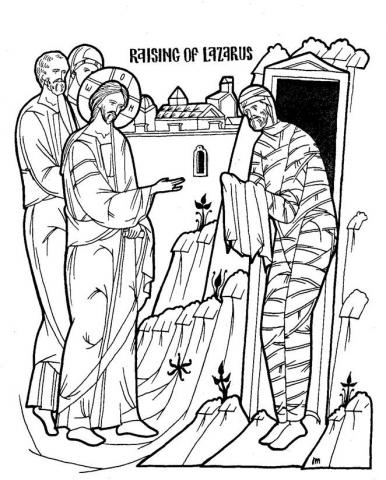Ages 3-5 The Gospels - Overview (Schedule, Recipes, etc..)
CHURCH SCHOOL
THE LIFE OF JESUS – THE GOSPELS
AGES 3-5
This file is provided as a resource for Church School directors. Feel free to plug in your own dates and your own teachers.
TEACHERS:
|
Date |
Lesson/Activity |
Teacher |
Special Notes |
|
September 12
18 19
26
|
Nativity of Theotokos/ Presentation of Theotokos
Movie Night Annunciation
Birth of John the Baptist
|
|
Outdoor, Parish-wide |
|
October 3
10
17
23 24
31
|
Nativity of Our Lord
Meeting of Our Lord
The Three Kings
Movie Night Flight to Egypt
Nazareth and the Temple/ All Saints Party
|
|
Memory Work: St. Simeon’s Prayer
Operation Christmas Child due Dress as favorite gospel character |
|
November 7
14
20 21
28
|
Theophany
Temptations of Jesus
Movie Night Wedding at Cana
Calling of the Fishermen
|
|
Memory : Troparion Jar Decorating
Jewish Dancing
Memory Work: Four Fishermen |
|
December 4 5
12
19
26 |
St. Nicholas Festival Calling of Matthew
Woman at the Well
Christmas Pageant
Sermon on the Mount |
|
10 AM-1 PM in hall
Memory Work: 1st Beatitude |
|
January 2
9
15 16
23
30
|
Walking on Water/Calming of Storm
Feeding of 5000
Movie Night Transfiguration
The Good Samaritan
Parable of the Sower |
|
Canned Goods 3 Kings Party
Health Kits |
|
February 6
13
17
27 |
Zaccheus
Publican/Pharisee
Prodigal Son
Last Judgment |
|
Homeless Bags
|
|
March 5 6
13
20
27
|
Movie Night Forgiveness/Paralytic
Miracles/Healing
Lazarus
Palm Sunday
|
|
Antiochian Art Contest
|
|
April 2 3
10
17
24 25
30 |
Marathon Movie Night Last Supper
Crucifixion
Resurrection
PASCHA: No Church School Easter Egg Hunt
Rehearsal for Passion Plan/Musical |
|
Memory Work: “Christ is Risen” in 3 languages
|
|
May 1
8
13-15
22
29 |
Passion Play/Musical
Doubting Thomas
Camping Trip Ages 6-12
Myrrh-bearing Women
Road to Emmaeus
|
|
For Parish/Public???
Piggy Banks Due |
|
June 5
12
19 |
Ascension
Pentecost
Lord’s Prayer |
|
Memory Work: Lord’s Prayer Awards Ceremony |
Classroom supplies: Each class is supplied with the following items:
Paper plates, small and large Scissors Stapler/Staples
Paper, plain and construction Tape and dispenser Paper bags
Glue or glue sticks Crayons and/or markers Cotton Balls
Popsicle sticks Chenille (colored pipe cleaners) Sharpies
If you use the last of something, please either replace it or let me know so I can replace it. If you need special craft supplies for your lesson, submit the receipt to me for reimbursement.
Books are available for class use. While each child in the younger classes will have a copy of the Beginner’s Bible, and it’s always fun to start out in your very own Bible book, many times we must supplement with the teacher’s copies of the Children’s Bible Reader, Read with Me Bible, Golden Children’s Bible, or other books. Watch the lesson plan for page numbers and details. Each has strengths and weaknesses: Children’s Bible Reader is Orthodox but no longer in print, First Bible has great pictures but not much content, Golden Bible has the most content and lovely pictures but way too long, etc. And not a one has ALL of the stories we need.
Teaching Schedule: We all know that there will be last-minute needs; trade with someone if you cannot teach on your assigned day and let the director know!
Insurance: Each of us must “apply” each year for our volunteer position of teacher. Please be sure not to send small children to the bathroom unattended and accompany your charges back to the Social Hall after class.
Opening Exercises: The Church School director will supervise this time, or delegate it when she is absent. Church School children and teachers are dismissed first from Liturgy; children come straight across for snack during opening exercises. These are an integral part of the curriculum – reviewing material from previous weeks, presenting additional Old Testament characters, rehearsing plays, hearing memory work, and playing quiz games.
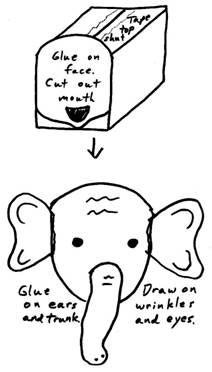
Curriculum: With each lesson, I have included True/False questions. If you have any 3-5-year-olds, make your classroom elephant now. He’s very easy, and each week, when we tell a story, we do true/false afterwards by writing the statements on paper peanuts and feeding the elephant the true ones and stomping on the rotten (false) peanuts. Just take a cardboard box, tape the top shut, and glue on an elephant face out of construction paper (or foam). Cut out a mouth big enough for paper peanuts to fit through. Glue on ears and a trunk, being sure to glue the trunk only above the mouth so the children can lift it to insert the good peanuts. Color in wrinkles and eyes. Then, each week, write the true/false statements on construction paper pieces cut like peanuts and go around the circle. Each child selects a “peanut”, you read it to him, and the class decides whether he should feed it or stomp it! Just be sure you have at least one paper peanut for each child!
Timeline: Too young for a timeline? Use the figures provided for the story, print on cardstock (one for the whole class or use it every week for your craft), decorate (color, glitter glue, wiggle eyes, yarn hair, etc.) and hang in order from a clothesline stretched along the room with clothespins or paper clips. Easy way to review past lessons and bring in the new.
Hand-Outs: Feel free to use the coloring pages in the Parents' Guide for take homes at the end of the lesson.
Movie Nights and Parties: We will have supper after vespers on Saturday night while showing a small children’s movie. Only on marathon movie night are we having a feature for older children with overnight. We also have lots of parties planned, as well as the St. Nicholas gala festival.
RECIPES
CLAYS PAINTS
SALT DOUGH FINGER PAINT (4 WAYS)
2 cups flour Use pudding with food coloring!
1 cup salt Mix liquid starch and food coloring.
about 1 cup water Mix 3 T sugar, ½ cup cornstarch, and
food coloring 2 cups cold water. Cook over
bath oil, vegetable oil, peppermint oil low heat, stirring, till thick.
Mix flour and salt. Add water Pour into muffin tin. Add
slowly and mix with your fingers until food coloring to each cup.
it makes dough. Knead in a few drops
food coloring and a splotch of oil (if SAND PAINT
desired). Store in air-tight container. Add dry tempera paint to corn meal.
Sprinkle over areas “painted” with thinned white glue
SELF-HARDENING CLAY
1 cup sand for a sand effect. Shake off excess.
½ cup cornstarch
1 tsp powdered alum PASTES
¾ cup hot water PRIMARY PASTE
Food coloring if desired Mix ½ cup water and 1 cup flour
Mix sand, cornstarch and alum in a bowl. Spoon into a jar
in large pot. Add hot water and stir or squeeze bottle to store.
vigorously. Add food coloring if
desired. Cook over medium heat PAPIER MACHE PASTE
until thick, stirring constantly. 3 cups water
After cooling, store in airtight container. 1 ½ cups flour
Mix flour with cold water until lumps are gone.
SAWDUST CLAY
2 cups fine sawdust Dip strips of newsprint in paste and mold around
1 cup flour surface to be shaped. Air dry.
Mix sawdust and flour in bowl
or bucket. Add a little water at a time,
stirring till it is stiff but pliable. Knead
till it’s elastic and easy to shape. Store
in airtight container. Air dry.
CORNSTARCH DOUGH
2 cups cornstarch
4 cups baking soda
2 ½ cups water
Mix cornstarch and soda in large
pot. Add water. Cook, stirring, over medium
heat until thick like mashed potatoes. After
cool, knead on wax paper for 5 minutes. Store
in an airtight container. Air dry.
Nativity of the Theotokos
NATIVITY OF THE THEOTOKOS AND PRESENTATION OF THE THEOTOKOS
Objectives:
1. Students should be able to tell the stories of these two great feasts.
2. Students should know the names of Joachim and Anna and Mary.
Possible Lesson Plan:
1. Open with prayer.
2. Read the story of the feasts:
There lived in the land of Israel a couple names Joachim and Anna. Joachim and Anna were Jews; God called the Jews His chosen, or special, people, and had given them His law and His prophets. Through the prophets, God had spoken to His special people, telling them that He would send His Son to be their king. And through the years, God had given the Jewish people many mighty and godly kings, like King David and King Solomon. Joachim and Anna were from the family of David. But, their own lives were sad because they had no children.
In those days, a family with no children was thought to be worthless. In church, Joachim and Anna could not give their gifts until all the families with children had finished worshipping. They were called cursed. Everyone thought that they must have done something very bad for God to punish them by not letting them have children. One day, when Joachim and Anna came to the temple to worship, a very cruel temple servant told them to go away and not to come back until all the people with children had finished!
Joachim and Anna left in silence. They were so sad. Anna went home, but Joachim went out to the desert mountains to pray and fast to the Lord. Anna stayed at home and also prayed and fasted. At the end of forty days, God sent an angel to Joachim as he prayed and one to Anna as she prayed. The angel told each of them something wonderful. God was going to give them a baby! Just like Sarah and Hannah, even though they were old, God was going to answer their prayers! Joachim hurried home to tell Anna the good news, but the angel had already told Anna. How happy they were! And, their baby would be the mother of the Messiah, the king that God had promised for hundreds of years.
What the angel had promised came true. Joachim and Anna, old as they were, did have a baby. They named their tiny girl Mary. She was truly beautiful. And they promised God that they would give her back to Him to serve Him.
Soon little Mary was three years old. She was traveling the long dusty road from her village of Nazareth to the gleaming city of Jerusalem. Her mother, Anna, and her father, Joachim, had promised her this journey as long as she could remember. It took five days to reach Jerusalem. Finally, instead of only dusty brown road, the travelers began to see the brightly-colored houses of Jerusalem. Then, as they came around the curve at the Mount of Olives, Mary saw the brilliant sun shining off the massive white and gold of the Temple. This was to be her home!
That very afternoon, Joachim and Anna dressed Mary in her very best clothes. They were happy, but sad, too. They would miss their little girl so much. But, a promise to God must be kept. Would Mary be lonely and afraid? They walked through the outer court of the temple, crowded with merchants, moneychangers, and sellers of all sorts of animals. As they reached the inner gate, Mary saw the temple virgins – young women dedicated to God – walking up the steps bearing torches of fire. This was truly her home! She left her parents and confidently climbed the same steps all by herself. The high priest gathered her in his arms and blessed her. Mary would stay there, living with the other girls, learning to fast and pray and to be pleasing to God. She was so happy!
The church celebrates the birthday of Mary on September 8. We celebrate her entrance into the temple on November 21.
3. Feed the Elephant True/False Questions:
True False
Mary’s parents were Joachim & Anna Mary’s father was Noah.
Mary was born in Nazareth. Mary was born in Jerusalem.
God sent an angel to Joachim & Anna. God called Joachim on the telephone
Mary climbed the temple steps by herself. Joachim carried Mary to the temple.
4. Review the story again, with the icons. Identify each figure. What was the role of each in the story? Ask the children: How did Joachim and Anna feel when they couldn’t have a child? How do you feel when people say bad things about you? Is it good to say bad things about other people? How did Mary feel when saying good-bye to her parents? Why did she climb the steps to the temple? Would you be brave enough to do that? Hang your string and add the first two timeline figures to start your timeline.
5. Have a birthday cake for Mary, complete with candles and song. If you feel particularly adventuresome, what about the children writing new words from their story for the “Happy Birthday” song?
6. Make the “Steps of the Temple.” Take a long piece of construction paper and fold like a fan into 15 steps (or fewer if it’s too hard). Using the pictures on the next page, copy and cut out each figure for each child. Color the figures and glue or tape a Popsicle stick behind each to make a puppet. Re-enact Mary climbing the steps of the temple.
7. 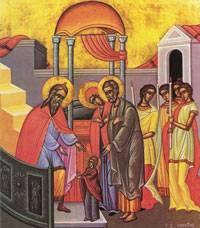
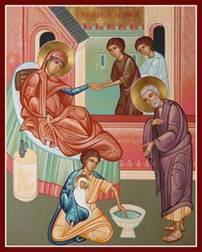 Close with prayer.
Close with prayer.
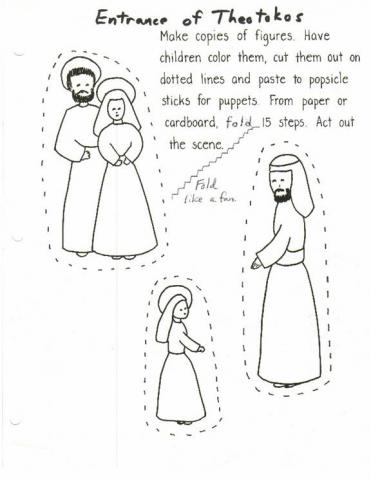
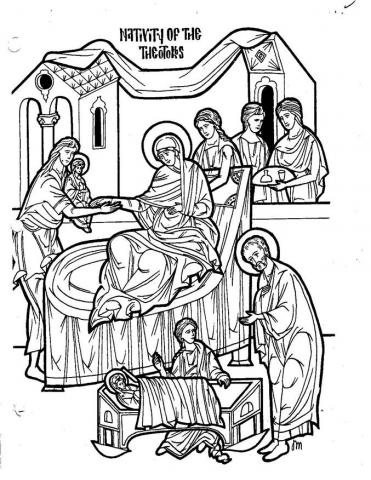
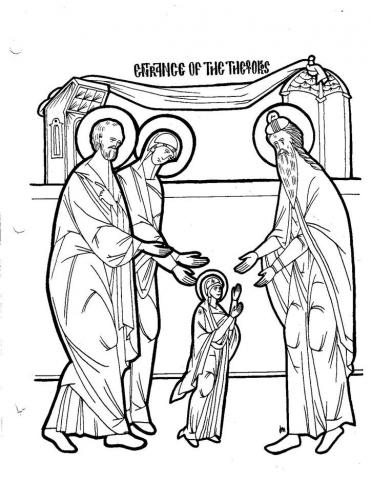
Annunciation
THE ANNUNCIATION
Objectives:
- Children should know that Mary was the mother of Jesus.
- Children should be able to say the word “Theotokos” and know its meaning.
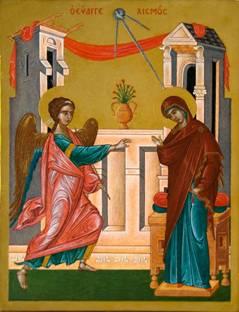
- Children should be able to say “annunciation” and know it means announcement.
- Children should be able to identify the angel Gabriel and Mary in the icon.
Possible Lesson Plan:
- Open with prayer.
- Read the story of the Annunciation in the Beginner’s Bible, pages 266-270, the Children’s Bible Reader, pages 164-165, or Read with Me Bible, pages 252-255. Supplement, if desired, with the Golden Children’s Bible, pages 348-349. Review the story with the icon, identifying Mary and Gabriel. What is Mary holding? She is shown holding a spool of thread because she was spinning thread when the angel appeared to her.
- Feed the Elephant True/False Questions:
True False
The angel Gabriel appeared to Mary. The angel Michael appeared to Mary
Mary was spinning thread. Mary was playing tag.
Mary was the mother of Jesus Anna was the mother of Jesus.
Annunciation means announcement. Annunciation means birthday.
Add the Annunciation to your timeline.
- Ask these questions: What was Mary doing when the angel came to talk to her? What would you want to be doing if an angel came to your house? Arguing with your sister or brother? Disobeying your parents? How do you think Mary felt when she saw the angel? How would you feel? Have any of you seen an angel? Why did the angel come to talk to Mary? Who would be the father of Mary’s baby?
- Make an Annunciation Plate to hang in your room.
- Close with prayer.
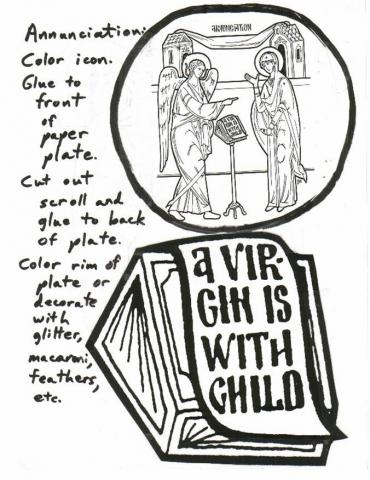
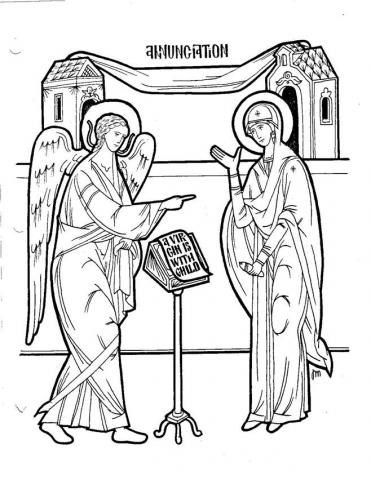
Birth of John the Baptist
BIRTH OF JOHN THE BAPTIST
Objectives:
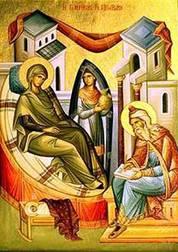 Children should be able to tell the story of Elizabeth, Zachariah , and the angel.
Children should be able to tell the story of Elizabeth, Zachariah , and the angel.- Children should be able to identify John as the child of Elizabeth and Zachariah.
Possible Lesson Plan:
- Open with prayer.
- Read the story of John’s birth in the Childen’s Bible Reader, pages 162-63 and 166-68, or the Golden Children’s Bible, pages 346-350. We also have the Arch book “Elizabeth’s Story”.
- Feed the Elephant/True/False Questions:
True False
Elizabeth and Zachariah were very old. Elizabeth & Zachariah hated children
Zachariah was a priest. Elizabeth was a priest.
The angel Gabriel spoke to Zachariah. The angel spoke to Elizabeth.
Zachariah couldn’t speak. Elizabeth couldn’t see.
Elizabeth & Zachariah’s baby was John. Elizabeth & Zachariah’s baby was
Mary.
Add the birth of John to your timeline.
- First review the stories of other “gift babies”: Mary to Joachim and Anna, Isaac to Abraham and Sarah, and Samuel to Hannah and Elkanah. You can even review the stories in the Read with Me Bible or Children’s Bible. What gift did God give to Elizabeth and Zachariah? How did they feel? What did Zachariah say to the angel? Did he believe God? Do you always believe God? Is it hard sometimes to do what God says? Why couldn’t Zachariah speak? What were his first words? Did he obey God in the end? Who visited Elizabeth before John was born? Remind the students that Mary and Elizabeth were cousins.
- Have another birthday cake and sing “Happy Birthday” to baby John. Can you make up words like a Troparion to go with “Happy Birthday” about John?
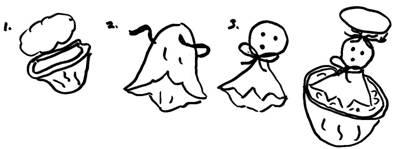 Make Baby John. Use a half walnut shell with a tiny piece of cotton ball for bedding. A little circle of fabric for the gown, tiny piece of cotton inside tied with a ribbon for the head. Draw on face. Add tiny piece of fabric for bonnet. OK, so, walnuts hard to come by? You can use a coffee filter for the baby with a cotton ball inside the head, rubber band or pipe cleaner around the neck, and toilet paper tube cut in half longways to make a "cradle". Decorate the cradle with birthday or baby stickers.
Make Baby John. Use a half walnut shell with a tiny piece of cotton ball for bedding. A little circle of fabric for the gown, tiny piece of cotton inside tied with a ribbon for the head. Draw on face. Add tiny piece of fabric for bonnet. OK, so, walnuts hard to come by? You can use a coffee filter for the baby with a cotton ball inside the head, rubber band or pipe cleaner around the neck, and toilet paper tube cut in half longways to make a "cradle". Decorate the cradle with birthday or baby stickers.
- Close with prayer. Use the prayer that Elizabeth prayed when she saw Mary coming: “Rejoice, O Birthgiver of God, Mary full of grace, the Lord is with you! Blessed are you among women, and blessed is the Fruit of your womb. For you have borne the Savior of our souls!”
Nativity
NATIVITY OF OUR LORD (CHRISTMAS)
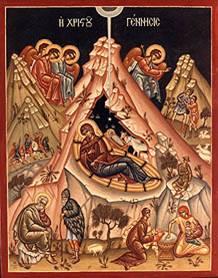 Objectives:
Objectives:
- Children should be able to identify Christmas as Jesus’s birthday.
- Children should know that Nativity means “birthday”.
- Children should be able to tell the story of the Nativity and identify the figures in the icon.
- Children should be able to repeat the greeting: “Christ is born! Glorify Him!”
Possible Lesson Plan:
- Open with prayer.
- Read the story of Christmas in the Beginner’s Bible, pages 271-281, the Children’s Bible Reader, pages 168-170, or the Read with Me Bible, pages 256-265. You can supplement with the Golden Children’s Bible, pages 351-352. Review the story with the children with the icon, having them identify the people, animals, and star and what each did in the story. If you want, print the puzzle icon on cardstock, either large for classroom use or smaller for a take-home and add each piece as you tell the story.
- Feed the Elephant True/False Questions:
True False
Jesus was born in a stable. Jesus was born in a palace.
Mary was Jesus’s mother. Elizabeth was Jesus’s mother.
Joseph was Mary’s husband. John was Mary’s husband.
Angels appeared to the shepherds. Goats appeared to the shepherds.
Christmas is Jesus’s birthday. Christmas is Mary’s birthday.
Nativity means birthday. Nativity means play day.
Add Nativity to your timeline.
- Bring in a crèche from home. Have children identify each item and place it in the scene as they retell the story. Be sure to leave the 3 kings out for now. Use it to decorate the classroom for the next 40 days.
- Practice the greeting: Christ is born! Glorify Him!” Go around the circle until each child can say each half of the greeting.
- Make an Angel/Sheep mobile. Copy enough angels and sheep for each child to have 4 of each. Cut out and decorate sheep with cotton “wool” and angels with glitter glue. Make a small hole in each and tie a short length of string. Then tie to a coat hanger with angels suspended over sheep. Use a tiny piece of tape to keep the angels from sliding down the hanger.
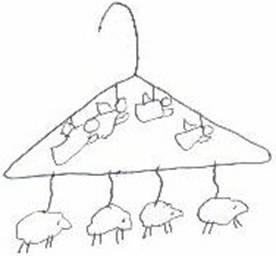
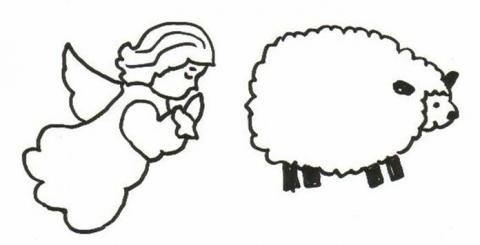
Mobiles really not your "think" or hangers in short supply? Then print the manger scene and the palm trees on cardstock. Cut them out with the slits. Children can color. Then use the slits to insert the palm trees and the entire scene will stand up!
- Close with prayer.

The Meeting of the Lord
THE MEETING OF THE LORD
Objectives:
- Children should be able to tell the story of the meeting of the Lord.
- Children should be able to identify Simeon and Anna, as well as Jesus, Mary and Joseph in the icon.
- Children should know what churching is and that this feast is its origin.
- St. Simeon’s prayer is our memory work this week.
Possible Lesson Plan:
- Open with St. Simeon’s Prayer: “Lord, now lettest Thou Thy servant depart in peace according to Thy word, for mine eyes have seen Thy salvation, which Thou hast prepared before the face of all peoples, a light to enlighten the Gentiles, and the glory of Thy people, Israel.”
- Read the story of the meeting in the Beginner’s Bible, pages 282-285, the Children’s Bible Reader, pages 173-174, or the Read with Me Bible, pages 266-269. You can supplement with the Golden Children’s Bible, pages 352-35. Review the story with the icon, identifying each character. What is the role of each? Why were Simeon and Anna there? Why were Mary, Joseph, and Jesus there? What is Joseph holding and why?
- Feed the Elephant True/False Questions:
True False
Mary & Joseph brought Jesus to the temple. Mary and Joseph brought Jesus to the playground.
Simeon was an old man. Simeon was an angel.
Simeon and Anna were waiting for Jesus. Simeon and Anna were eating lunch
Simeon and Anna were god-fearing people. Simeon and Anna hated God.
Add the Meeting of the Lord to your timeline:
- Bring an infant baby doll, wrapped in a blanket. Tell the children that each baby is brought to the church when he or she is a few weeks old. Just as in the days of Jesus, the mothers and fathers thank God for their new child and ask Him to take care of their baby and help him to grow up as a good member of God’s family. This is called churching. Act out a churching, with the teacher as priest, and a little girl holding the baby, a little boy as father.
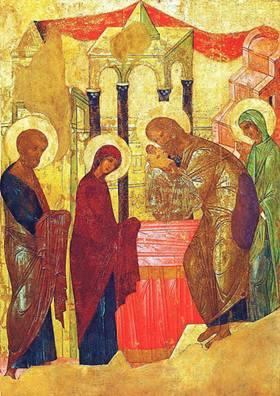
Priest: Let us pray to the Lord. O Lord God Almighty, Father of our Lord Jesus Christ, purify this woman, (name), from all sin and bless thou the child, (name), who is born of her. (Make the sign of the cross over the child.) As Thou, O Lord, wast brought on the fortieth day as an infant in to the Temple according to the Law by your mother, Mary, and wast carried in the arms of Simeon the Just, do Thou, O Master, bless this baby who is brought here. For unto thee are due all glory, thanksgiving and worship. Amen.
- We bless candles on this feast day. Simeon and Anna were two old people who had been waiting a long time for Jesus, who would be the light of the world. We celebrate the light of Jesus with the blessing of candles. We use candles made of beeswax because God gives us His bees to make the wax.
- Make a “Beeswax” Candle. Give each child a half sheet of yellow construction paper. Have them color the sheet with brown crayon, approximating the appearance of beeswax. Roll into candle shape and glue or tape. If desired, decorate with tiny chenille bees (available at craft stores) or bee stickers. Finally, cut flame from orange or yellow paper and glue or tape at top of candle. Remind children that Je
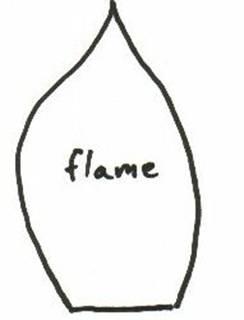 sus is the light of the world. Want to make a real candle? Take sheets of beeswax, easily available, and roll them into candle shape. If you use beeswax candles at church, take the thinnest ones as the center and you have your wick provided. It's easy to decorate them with chenille bees, which come on a wire just ready to stick into the beeswax "honeycomb".
sus is the light of the world. Want to make a real candle? Take sheets of beeswax, easily available, and roll them into candle shape. If you use beeswax candles at church, take the thinnest ones as the center and you have your wick provided. It's easy to decorate them with chenille bees, which come on a wire just ready to stick into the beeswax "honeycomb".
- Close with St. Simeon’s Prayer. Recite the prayer line by line with the children repeating. Or try singing it a couple of times like we do at vespers. Do it all together at the end with lighted candles.
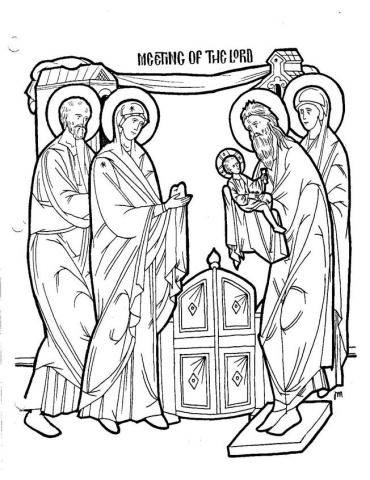
The Three Kings
THE THREE KINGS
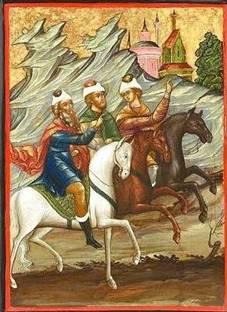
Objectives:
- Children should be able to tell the story of the three kings, or wise men.
- Children should know that the star guided the wise men to Bethlehem.
- Children should be able to name Herod as the wicked king who wanted to kill Jesus.
- Children should be able to name the gifts the kings gave the baby Jesus.
Possible Lesson Plan:
- Open with prayer. Review St. Simeon’s prayer. Have the children memorized it yet?
- Read the story of the three kings in the Beginner’s Bible, pages 286-290, the Children’s Bible Reader, pages 170-173, or the Read with Me Bible, pages 270-276. Supplement if desired with the Golden Children’s Bible pages 354-357. Review the icon of the Nativity. Where are the three kings? Add them to your crèche and review all the other figures in the icon and the crèche scene. Does the Bible actually tell us how many kings there were? (no)
3. Feed the Elephant True/False Questions:
True False
Herod was King of Judea. Herod was one of the wise men.
The kings brought gifts for baby Jesus. The kings hated baby Jesus.
Herod hated baby Jesus. Herod loved baby Jesus.
The kings followed a star. The kings followed a kite.
Jesus was born in Bethlehem. Jesus was born in Baltimore.
Add the Three Kings to your timeline:
4. Ask some questions: What were the gifts of the kings? Why did they bring these gifts? Why did Herod hate Jesus? What did God tell the wise men to do?
5. Make the Three Kings Stand-up Figures. Cut kings out of the pattern on the next page from blue, purple, red or other kingly colors of construction paper – one of each color for each child. Cut only the center section in white and glue inside the robe. Color face and hair. Use gold glitter glue for crowns. Finally, glue or tape a small gold chocolate coin inside one robe, a piece of incense inside another, and rub a bit of perfume or add a scratch and sniff sticker inside the third. Fold the robes closed and the figures will stand up. Open to see the gifts.
6. Close with prayer.
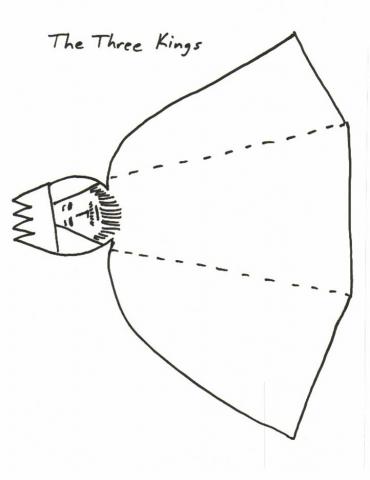
Flight to Egypt
FLIGHT TO EGYPT
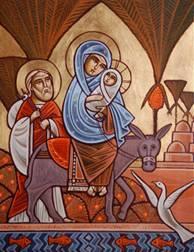
Objectives:
- Children should know how God’s angel helped Joseph care for Jesus.
- Children should know a little about Egypt and Moses.
- Children should recognize Herod as the wicked king who killed the children.
Possible Lesson Plan:
- Open with Prayer.
- Read the story in the Beginner’s Bible, pages 291-295, the Children’s Bible Reader, pages 174-175, or the Read with Me Bible, pages 277-279. Supplement if desired with the Golden Children’s Bible, pages 356-357. What did Mary and Jesus ride? Have the children pick the donkey out of the crèche scene. Who warned Joseph? Who wanted to kill Jesus? Why? Where were Joseph and Mary and Jesus living and where did they go? Why Egypt?
- Feed the Elephant True/False Questions:
True False
An angel warned Joseph about the danger. Joseph heard a warning on the radio.
Mary and Jesus rode a donkey. Joseph, Mary, and Jesus rode a car.
Jesus was born in Bethlehem. Jesus was born in Egypt.
King Herod wanted to kill Jesus. King Herod loved Jesus.
Add the Flight to Egypt to your timeline:
- Bring a small suitcase to class. Has any of the children taken a long trip with his family? What for? Explain that it was a long trip to Egypt and the Joseph family had to pack in a hurry to escape the angry king. Re-enact the story, having the children each pretend to put into the suitcase something that the family would need for the journey. Why was this object needed? Then take a quick trip to Egypt, taking turns carrying the suitcase, marching around the room or around the playground. Now we’re in Egypt. What happened in Egypt? Review the stories of Joseph and Moses from the Old Testament briefly. What happened in Bethlehem after they left?
- Play Pin the Tail on the Donkey: Draw or print large donkey on poster board, or just buy one. Make a construction paper tail for each child. Tape the tail for each child on the donkey with masking or clear tape where it landed, blindfolded of course. Winner gets the donkey?
6. Make Herod’s Soldiers: Take a toilet paper tube. Wrap it with a strip of red construction paper until it’s all covered. Use a thin strip of white paper for the face. Cut the helmet from gray and decorate with red feathers (like Roman soldiers). Cut thin strips of red for arms and glue on tiny white hands. Glue to your soldier. Finish by drawing in the face. Fancy? Decorate the “uniform” with gold metallic ribbon or braid and use chenille pipe-cleaners for arms to hold tiny swords or spears.
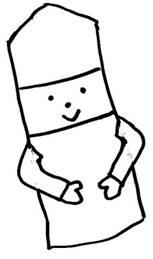
7. Close with prayer.
Nazareth and Trip to Jerusalem
NAZARETH AND THE TRIP TO JERUSALEM
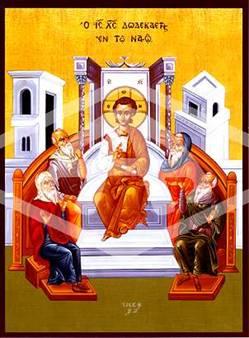 Objectives:
Objectives:
- Children should identify Nazareth as the childhood home of Jesus.
- Children should know that Joseph was a carpenter, and so was Jesus.
- Children should be able to relate the story of the trip to Jerusalem and Jesus talking with the elders in the Temple.
Possible Lesson Plan:
- Open with prayer.
- Read the story of Jesus’s childhood in the Beginner’s Bible, pages 296-302, the Children’s Bible Reader, pages 175-177, or the Read with Me Bible, pages 280-285. Supplement if desired with the Golden Children’s Bible pages 358-359. You could also use the flannelgraph story in the cupboard on our flannelboard. Why did the family come back from Egypt?
- Feed the Elephant True/False Questions:
True False
Jesus grew up in Nazareth. Jesus grew up in Bethlehem.
Joseph was a carpenter. Joseph was a priest.
Jesus and his family went to Jerusalem. Jesus and his family went to Florida.
Jesus was found in the Temple. Jesus was playing tag on the street.
Add Jesus's boyhood to the timeline:
- Discuss the love of our families: How are some ways our parents take care of us? (food, clothing, a house, etc.) How did Mary and Joseph care for Jesus as a boy? (many of same ways) What does your father or mother do at work? At home? What did Joseph do for a living? What’s a carpenter? Do you help your daddy? Do you think Jesus helped his daddy build things? How do you help your mommy? Do you think Jesus did, too? Bring in some wood; we have hammers and nails. Play carpenter for a few minutes.
5. Reenact the journey to Jerusalem: Have children play the roles of Jesus, Mary, Joseph, and caravan members. Travel from your classroom to the sanctuary.
On the road to Jerusalem: Stop and ask “Why are you going to Jerusalem? What are you looking forward to? What do you see on the road?”
In the Temple: Stop and ask, “What are you doing in the Temple?” Have the whole class pray the Lord’s Prayer together in the sanctuary. Jesus stays in sanctuary; rest of class moves to vestibule.
In the vestibule, about ready to go home, ask, “Where are you ready to go now?” Are you happy about your trip to Jerusalem?”
Camping in the playground that night, ask, “Mary and Joseph, what have you just noticed? How do you feel? What will you do?”
Back in the sanctuary, ask “Jesus, what are you doing? Why did you stay behind? Mary and Joseph, how do you feel now that you’ve found Jesus? Jesus, what do you tell Mary and Joseph?”
Back to the classroom, ask, “Where are we now?” Did we have a good trip?”
6. Make “Taller and Taller”. Copy the face of Jesus pattern and cut out for each child, or cut circles for faces, and color. Cut hands and feet. Using strips of poster board and brads, assemble the growing apparatus. Glue on hands, feet, and heads. Watch Jesus grow up!
7. Close with prayer.

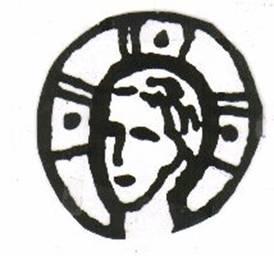
Theophany
THEOPHANY
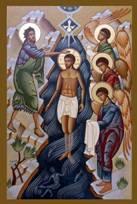 Objectives:
Objectives:
- Children should be able to tell the story of Jesus’s baptism by John.
- Children should name the River Jordan as the site of Jesus’s baptism.
- Children should be able to identify Jesus, John, and the dove in the icon.
Possible Lesson Plan:
- Open with prayer.
- Read the story of Jesus’s baptism in the Beginner’s Bible, pages 303-307, the Children’s Bible Reader, pages 177-179, or the Read with Me Bible, pages 286-289. Supplement with the Golden Children’s Bible, pages 360-361. Review the story with the icon, identifying the characters and their roles. Remind the children that John was Jesus’s cousin. Review briefly the story of John’s birth; do the children remember it? Review the importance of the crossing of the Jordan River in the Exodus from Egypt in the days of Joshua.
- Feed the Elephant True/False Questions:
True False
Jesus was baptized in the Jordan River. Jesus was baptized in the Temple.
Jesus was baptized by John. Jesus was baptized by Joseph.
John was Jesus’s cousin. John was Jesus’s father.
The Holy Spirit appeared as a dove. The Holy Spirit appeared as a spider.
Add Theophany to your timeline:
- Review the custom of House Blessing. Does any of the children remember their house being blessed? When do we bless houses? Who blesses them? What do we use? Where do we get the Holy Water? Let them know that we will be able to decorate jars for Holy Water today after Church School that they can use for their House Blessing later this year. What do we sing? Practice the Troparion of Theophany with the children.
- Ask the children if they have ever seen a baptism? What’s it like? Why are we baptized? (to become part of God’s family, the Church) Sing together “As many as have been baptized…” How was Jesus’s baptism like our baptisms? Different?
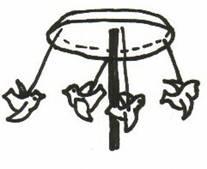
- Make the Flying Doves mobile: Cut four doves for each child from white construction paper using the pattern. Cut a slit in the body of each dove. Slide the wings into the body and tape to hold. Decorate wings with white feathers if desired. Tie a string through a small hole on the top of the dove’s body and the other end of the string along the edge of a large paper plate. Attach an unsharpened pencil to the center of the plate with a thumbtack into the eraser end. Spin the plate to make the doves “fly.”
- Close with the Troparion and prayer.
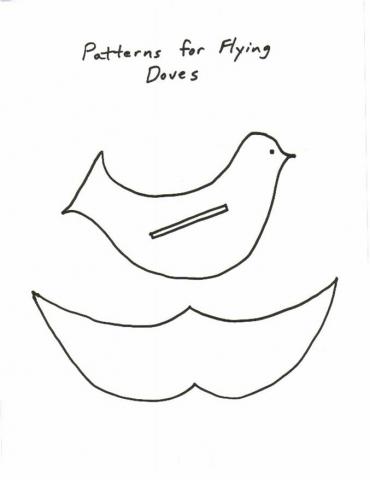

Temptations
TEMPTATIONS
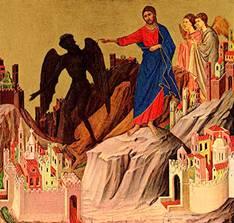
Objectives:
- Children should identify the devil, Satan, as the one who tempted Jesus.
- Children should know that Jesus did not sin.
Possible Lesson Plan:
- Open with prayer.
- Read the Children’s Bible Reader, pages 180-181, Golden Children’s Bible, pages 362-363 (It’s not in the Beginner's Bible or the Read with Me Bible.), or the really good Arch book, “The Temptations of Jesus”. Where did Jesus go after His baptism? What is the desert like? How long did Jesus spend without food and water? What would that feel like? Who is Satan? Review the story of Adam and Eve. What three temptations did Satan present to Jesus? Did Jesus sin?
- Feed the Elephant True/False Questions:
True False
Satan tempted Jesus. God tempted Jesus.
Jesus went to the desert after His baptism. Jesus went home to Nazareth.
Jesus didn’t eat or drink for 40 days. Jesus had plenty to eat and drink.
Add Temptations of Jesus to your timeline:
- Ask some questions: Have you ever been tempted to do wrong? To disobey God or your parents? What might tempt you? Did you give in and do the wrong thing? Is it hard to always obey God and your parents?
- Play “Pin the Cross on the Devil”: Make a black paper or poster-board devil and tape it to the classroom wall. Make a small paper cross for each child. Glue a red heart on the devil. Blindfold the children one by one and have them pin or tape their cross to the devil. Whoever is closest to the heart is the winner!
- Make Candy Snakes: How did Satan appear to Adam and Eve? We’re making the serpent and then we can eat him up! Have a box of colored ring cereal (e.g. Fruit Loops) and a pack or 2 of Lifesavers. Tie one end of a 12-inch string around a Lifesaver. Then have the children thread on the cereal until they have a nice snake length. Tie another Lifesaver onto the other end. This one’s so easy, the children can make 2 or 3 if they want.
- Close with prayer.
Wedding at Cana
WEDDING AT CANA
Objectives:
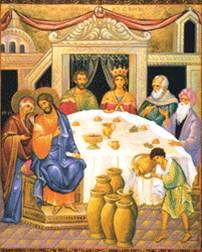 Children should identify the water into wine as Jesus’s first miracle.
Children should identify the water into wine as Jesus’s first miracle.- Children should know the word “miracle” and what it means.
- Children should recognize that the wedding at Cana is part of our wedding service.
Possible Lesson Plans:
- Open with prayer.
- Read the story of the wedding at Cana in the Beginner’s Bible, pages 314-317, the Children’s Bible Reader, pages 184-185, or the Read with Me Bible, pages 295-297. Supplement with the Golden Children’s Bible, page 366. Why was Jesus in Cana? Who asked him to supply more wine? How was the wine supplied? Remind the children that this was Jesus’s first miracle. What is a miracle? Say the word a few times and have the children repeat it.
- Feed the Elephant True/False Questions:
True False
Jesus went to a wedding at Cana. Jesus went to a wedding in Jerusalem
Mary asked Jesus for more wine. The bride asked Jesus for more wine.
Jesus turned water into wine. Jesus turned grapes into wine.
Jesus’s wine was the best ever. Jesus’s wine was sour and nasty.
Add the Wedding at Cana to your timeline:
- Talk a bit about weddings. Has any of the children ever been to one? What happens? Discuss the bride and groom, the service and priest. Play-act a wedding with children as bride and groom, priest, and Jesus and Mary and the other guests. What happens after the ceremony? (reception/party) What’s a party like? What do you like to have at a party? What might grown-ups like to have? What would it be like to run out of drinks with all those guests?
- Usually, there’s singing and dancing at a Jewish wedding. Do a dance or two that you learned last night at the movie night.
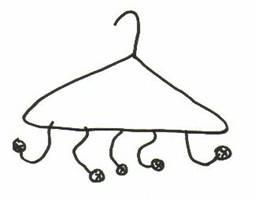 Make a wedding instrument: Coat Hanger Jingle. Have several jingle bells and one coat hanger for each child. Cut several pieces of string or yarn, about 6 inches in length. Tie one end of each string to a jingle bell and one to the coat hanger, securing with a piece of tape so they don’t slide around. Dance around the room with your new instruments.
Make a wedding instrument: Coat Hanger Jingle. Have several jingle bells and one coat hanger for each child. Cut several pieces of string or yarn, about 6 inches in length. Tie one end of each string to a jingle bell and one to the coat hanger, securing with a piece of tape so they don’t slide around. Dance around the room with your new instruments.
Close with prayer.
Calling of the Fishermen
- CALLING OF THE FISHERMEN
 Objectives:
Objectives:
- Children should be able to name the four fishermen.
- Children should be able to tell the story of the miracle of the full nets.
- Children should be able to say the word “disciple” and know that Jesus’s disciples were His closest followers.
Possible Lesson Plan:
- Open with prayer. After praying, get out some little pretzels, even better if you can find the "windowpane" pretzels that look just like nets, icing colored blue, and goldfish crackers. As you read, children can dab blue icing on their "nets" and stick a "fish" in the "net" and eat their catch.
- Read the story of the calling of the fishermen in the Beginner’s Bible, pages 308-310, the Children’s Bible Reader, pages 182-184, the Read with Me Bible, pages 290-293, or the Golden Children’s Bible. When did Jesus first meet Andrew? (He was a follower of John the Baptist.) Why is Andrew called the “First-called”? Who was Andrew’s brother? (Simon, later named Peter by Jesus) Who were the sons of Zebedee, also brothers? (James and John) What do you think Peter said when he saw all those fish in his net? Why did the fishermen give up fishing to follow Jesus?
- Feed the Elephant True/False Questions:
True False
Andrew was the first called. Peter was the first called.
Peter and Andrew were brothers. Peter and John were brothers.
James and John were sons of Zebedee. Peter & James were sons of Zebedee.
Add the fishermen to your timeline:
- Talk a bit about being a disciple. What is a disciple? Repeat the word until the children know it. Jesus had 12 close disciples, but many followers. What did the fishermen have to do to become Jesus’s disciples? Did they enjoy fishing? How do you think they felt leaving their homes and families? Was it easy being a disciple? We are also Jesus’s disciples. What does Jesus ask us to do? Is it always easy?
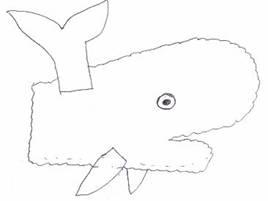
- Begin to list and memorize the 12 disciples: Peter and Andrew, James and John, Matthew, Philip and Nathaniel Bartholomew, Simon the Zealot, James (the Less), (Doubting) Thomas, Judas, and Judas Iscariot.
- Make Mitten Fish: Take a children’s mitten. Cut tail and fins from felt and glue or staple on. Use 2 tails, one stapled on each side and fins glued together for maximum stability. Use either wiggle eyes or felt eyes. Have the children use their fish in retelling the story.
- Alternate craft: Fishers of Men -- Take 2 large craft sticks and print the Scripture verse with Sharpie. Cut 1 square of netting for each student like on a bag of onions or box of fruit. Glue figures of 4 fishermen and some fish to the net and the net to the craft sticks and decorate with fish stickers if desired. Glue or staple a pipe cleaner across the top for a hanger.
Close with prayer.
Calling of Matthew
- CALLING OF MATTHEW
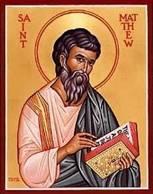
Objectives:
- Children should know that Matthew was a tax collector.
- Children should know that Matthew was one of Jesus’s disciples.
- Children should memorize the four fishermen and Matthew.
Possible Lesson Plan:
- Open with prayer.
- Read the story of Matthew in the Beginner’s Bible, pages 311-313, the Read with Me Bible, page 294. Supplement with the Golden Children’s Bible, pages 370-371 or the Arch book, “The Man Who Learned to Give”. What was Matthew’s job? Was he liked by most people? Why or why not?
- Feed the Elephant True/False Questions:
True False
Matthew was a tax collector. Matthew was a doctor.
Jesus went to Matthew’s house. Jesus hated Matthew.
Matthew was Jesus’s disciple. Matthew hated Jesus.
Matthew gave back the money he stole. Matthew stole Jesus’s money.
Add Matthew, the tax collector, to your timeline:
- Talk a bit about liking people: What makes someone a good friend, a nice person? Have the children come up with some characteristics. What makes someone a “bad” person? Did most people think Matthew was a nice person or a bad person? Why? Did most people like Matthew? Did they visit him? Were they nice to him? How did Jesus treat Matthew? Do you know some people who are not so nice? How do we treat people who are not so nice? Are we being like Jesus?
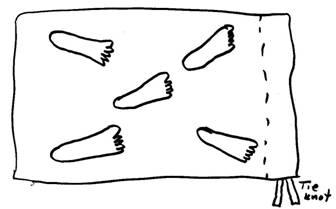 Make the Followers Footprints: Begin with a pillowcase for each child. Loosen a small area of hem at one seam and insert a piece of clothesline, tying the ends together as a drawstring. In class, place acrylic paint, thinned with fabric medium if desired, in shallow pan. Have each child step in the pan, or paint the child’s foot with a sponge. Make each child’s footprint on each pillowcase; add the name of the child “disciple” in permanent marker. Sort of a footprint autograph duffelbag!
Make the Followers Footprints: Begin with a pillowcase for each child. Loosen a small area of hem at one seam and insert a piece of clothesline, tying the ends together as a drawstring. In class, place acrylic paint, thinned with fabric medium if desired, in shallow pan. Have each child step in the pan, or paint the child’s foot with a sponge. Make each child’s footprint on each pillowcase; add the name of the child “disciple” in permanent marker. Sort of a footprint autograph duffelbag!
6. Too messy? Try this one instead working on the 12 disciples, now all called by the Lord. Just write the names on ahead of time with a sharpie, let the children draw on faces and color, use glue dots to attach to carrying rod to make a nice display at home or in the car.
7. Close with prayer: Lord Jesus, help me to love even people who are not nice to me and to be like You.
Woman at the Well
THE WOMAN AT THE WELL
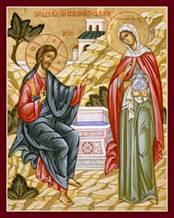
Objectives:
- Children should be able to tell the story of Jesus and the woman at the well.
- Children should be able to say the word, “evangelism” and know that it means telling people about Jesus.
Possible Lesson Plan:
- Open with prayer.
- Read the story of the woman at the well in Children’s Stories of the Bible pages 154-157 or The Zondervan Bible Storybook (2 copies total) on page 246. It is not in the Read with Me or the Children’s Bible. Don't have those books? Here's the story in a nutshell:The Story of the Woman at the Well
-
Why was Jesus at the well? Where were the disciples? What was the woman doing? What did Jesus say to her? What did she do? The woman at the well is remembered as a saint to this day; her name is St. Photini. Have the children repeat the name a few times. What are their names?
- Feed the Elephant True/False Questions:
True False
Jesus was sitting at a well. Jesus was sitting in his car.
A woman came to draw water. A woman came to buy a goat.
She went and told everyone to come. She went home for a nap.
Add the Woman at the Well to your timeline:
- Talk a bit about evangelism: Say the word and repeat it until the children know it. What does it mean? Was that what the woman at the well did? Was she excited to tell her friends what Jesus had said? Is there anyone you know who does not know about Jesus? Have you told them? Why or why not?
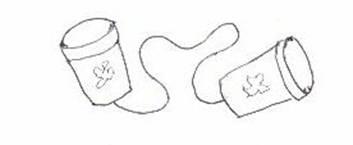 Make Good News Telephones: Take 2 paper cups and a length of string for each child. Decorate or color the cups, or write Good News on each. Poke a small hole in the bottom of each cup and slip string through and knot. Can you speak into one cup and hear in the other; be sure the string is pulled taut.
Make Good News Telephones: Take 2 paper cups and a length of string for each child. Decorate or color the cups, or write Good News on each. Poke a small hole in the bottom of each cup and slip string through and knot. Can you speak into one cup and hear in the other; be sure the string is pulled taut.
- Close with prayer. Lord Jesus, make me so excited that I want to tell everyone about you, like the woman at the well.
Sermon on the Mount
SERMON ON THE MOUNT
Objectives:
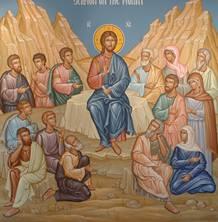 Children should know that the Sermon on the Mount is full of teachings of Jesus.
Children should know that the Sermon on the Mount is full of teachings of Jesus.- Children should know that Jesus is the light of the world.
- Children should memorize the first Beatitude.
Possible Lesson Plan:
- Open with prayer.
- Read the Beginner’s Bible, pages 318-321, the Children’s Bible Reader, pages 193-197, or the Golden Children’s Bible. There is also an Arch book about the Beatitudes. All classes are working on the Beatitudes; the smallest class will focus on Jesus as the light of the world. Review the story of Creation: God created light.
- Feed the Elephant True/False Questions:
True False
Jesus is the light of the world. Jesus is dark and cold.
God created light. Adam created light.
God blesses the poor in spirit. God blesses the braggers.
Add the Sermon on the Mount to your timeline:
- Give each child a candle. Light one central candle. This is Jesus, the light of the world. Turn out the lights. See how the candle gives us light in the darkness. Light each child’s candle from the central candle. See how much more light there is, now that we also show the light of Jesus. Blow out all the candles. What is the darkness like, with no light? Sing “This Little Light of Mine”.
- Begin to memorize the Beatitudes. The smallest children only need to know the first, “Blessed are the poor in spirit, for theirs is the kingdom of heaven.” All other classes will need to know the whole Beatitudes. Say or sing it together to begin the memory work to be continued at home. Can each child say it? What is the kingdom of heaven? Have the children brainstorm a bit about what heaven is like? (bright, beautiful, wonderful). Remind them that Jesus says “Seek ye first the kingdom of God.” Do we always seek His kingdom? What are some things that we really want? Do we want these things more than God’s kingdom? If we could go to the state fair or to church on Sunday, which would we choose? Why? Which should we choose?
- Make a decorated candle; you can use this for your House Blessing in a couple of weeks, or for Christmas. Take a pillar-type candle. Star and cross stickers would look really nice all up and down the candle. Place clear paraffin in a can and place on warming tray or hot plate – i.e. melting during Liturgy in a metal or glass container on the hot plate. Dip the candles in the hot paraffin to affix the stars. Set on wax paper to harden for a few minutes before taking home. OR take a standard votive candle, short one or tall week-long one used in your parish. Decorate with Sharpies or, for more fun (and more mess), mix Mod-Podge with food coloring and paint, producing "stained glass". Take home and burn all week in your home icon corner or place in the sanctuary of your parish.
- Close with prayer. Use the Lord’s Prayer, also from the Sermon on the Mount.
Walking on Water and Calming the Storm
WALKING ON WATER AND CALMING OF STORM
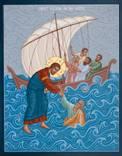 Objectives:
Objectives:
- Children should be able to tell the story of the two miracles in their own words.
- Children should be able to identify Peter as the disciple who walked on water.
Possible Lesson Plan:
- Open with prayer.
- Read the stories of the miracles in the Beginner’s Bible, pages 334-339 and 364-370, the Children’s Bible Reader, pages 193-197, or Read with Me Bible, pages 304-307 and 318-323. Supplement, if desired, with the Golden Children’s Bible, page 404. What was Jesus doing in the boat when the storm came? How did the disciples feel? How did Jesus respond? Who came walking across the water? Who wanted to walk with Jesus? What happened when Peter looked down? How did Jesus respond?
- Feed the Elephant True/False Questions:
True False
Jesus was sleeping thru the storm. Jesus was afraid of the storm.
The disciples were afraid of the storm. The disciples loved storms at sea.
Jesus told the wind to be quiet. The boat sank.
Peter walked with Jesus on the water. John walked with Jesus on the water.
Snack today? Try Stormy Seas Jello – Make blue jello ahead of time in individual cups. Spray with whipped cream for clouds. Add piece of chocolate bar for boat, with whipped cream sail. Sprinkle with Swedish fish.
Add The Boat in the Storm to your timeline:
- Talk a bit about storms: What are storms like? Lightning? Thunder? Wind? Bring some library books with pictures of storms or try making a storm in the room by turning out the lights, blinking them, and beating on a pot. Make a “storm dish”: Fill pie pan (or other shallow pan) with water. Add some blue food coloring and a tablespoon of vinegar. Float a small plastic boat in the water. Sprinkle a small amount of baking soda into the water like rain. Watch the “storm” of bubbling waves and the boat. Or take a blue tablecloth or tarp and have children hold it all around. They can make waves by shaking the cloth; see what happens to a toy boat in the middle. Have the children imagine they are in a storm. Are you afraid of the thunder or lightning? Why or why not? Is God in charge of the world even in a storm? Can we trust God? What is water like? Think about swimming a bit. How do we keep from sinking? Can we breathe under water? Do you like to swim? Play-act swimming on the classroom floor. Now stand up and walk. Can we walk on water usually? Why could Jesus walk on the water? (He trusted God.) Did Peter trust Jesus? Completely? Is God in charge even of the water? Can we trust God?
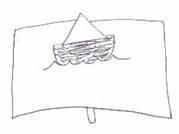
- Make a Sailing Ship. Take a piece of blue construction paper. Color the upper half black, or use black fingerpaint, for the night storm. Clear-drying glue can be rain and gold glitter glue can draw lightning. Cut a slit about 5 inches long in the center. Cut boat bottom from brown construction paper and sail from white. Glue together and glue Popsicle stick behind. Now stick the ship thru the slit and make it sail the storm.
- Another option for craft: Make a rocking paper plate sea by folding a blue paper plate into three equal sections
 and glue on a sailing ship. Now you can rock the sea!
and glue on a sailing ship. Now you can rock the sea! - Close with prayer, asking God to help us trust Him even in a storm.
Feeding the 5000
FEEDING THE 5000
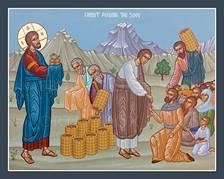
Objectives:
- Children should identify this as a miracle of Jesus.
- Children should know the little boy shared 5 loaves and 2 fishes.
- Children should know that Jesus fed 5000 people after blessing the food.
Possible Lesson Plan:
- Open with prayer.
- Read the story in the Beginner’s Bible, pages 357-363, the Children’s Bible Reader, pages 210-211, or the Read with Me Bible, pages 312-317. Supplement, if desired, with the Golden Children’s Bible, pages 402-403, or the Arch Book, “The Boy Who Gave His Lunch Away”. What was Jesus doing? Why were so many people there? They must have been hungry. What did Jesus feed them? Where did He get the food? What did Jesus do with it? What was left over? Was this a miracle? How did the disciples feel?
- Feed the Elephant True/False Questions:
True False
Jesus was teaching in the wilderness. Jesus was in a restaurant.
The little boy had 5 loaves and 2 fish. The little boy had a steak and peas.
Jesus fed 5000 men from the blessed food. Jesus sent the people to town to buy food.
Add Five Loaves and two fishes to your timeline:
- Try a sharing demonstration. Bring to class a batch of brownies, enough for half the class. Hand out the brownies to half the students; let the others see that there are no more. Are there comments about not being enough? Ask the children what they can do about this situation. When they come up with the answer, cut each brownie in half. Now there are enough for everyone. Eat the brownies while you talk about sharing: Did the little boy have to share his food? Why did he share? No one forced him to share his food – he wanted to. Jesus teaches us to share food with others. Do you bring lunch or snack to school? What if someone asks for something especially delicious from you? Will you share? Are there other ways we can share? Think about some and write them down.
- Make a basket of bread and fish. Make the basket by cutting a paper plate in half and stapling the halves together along the rim. Color brown. Add a construction paper handle. Now give each child 2 fish and 5 loaves from the patterns. Color the fish and loaves and put them in the basket. Pretend they are the little boy, bringing his lunch. What will they do?
- Close with prayer, asking Jesus to help us to be sharing people, as was the little boy.
LOAVES AND FISHES PATTERNS
Transfiguration
TRANSFIGURATION
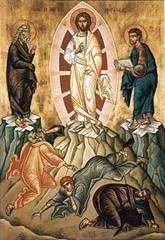 Objectives:
Objectives:
- Children should be able to tell the story of the Transfiguration.
- Children should be able to say the word “transfiguration” and know that it means “Change”.
- Children should be able to identify each character in the icon and his role in the story.
Possible Lesson Plan:
- Open with prayer.
- Read the story of the Transfiguration in the Children’s Bible Reader, pages 218-219 or the Golden Children’s Bible, pages 406-407. Show the icon. Have the children identify the figures and retell the story in their own words using the icon. Say the word “transfiguration” several times until the children can repeat it easily. What does it mean? Who was transfigured? In what way? Who did Jesus speak to? Which disciples came with Him?
- Feed the Elephant True/False Questions:
True False
Jesus shone with dazzling white robes. Jesus turned pink and purple.
Peter, James, and John came with Jesus. Mary and Joseph came with Jesus.
Jesus spoke with Moses and Elijah. Jesus spoke with King Herod.
Add Transfiguration to your timeline:
- Review the Old Testament stories of Moses and Elijah; both are in the Read with Me and Children’s Bible. Why would God have chosen these two men for Jesus to speak to?
- The Feast of theTransfiguration is celebrated on August 6. We bring fruit to church on the feast. Why? We are asking God to bless the harvest of fruit and the crops, which are just becoming ripe at this time.
- Make a Come Alive Mural: Draw the icon HUGE on a humongous piece of bulletin board paper. Cut out the faces of the people. Have the children each color one of the figures. Then, hold the giant icon up near the wall of the room. Have each child put his face in the place of his person. Let them one by one step down and see each other. You may need to do this part in the Social Hall with the help of the parents. Finally, cut the masterpiece apart so each child can take home his portion.
- Alternate (smaller) craft idea: Print icon on cardstock. Cut out the figures carefully ahead of time, making puzzle pieces. Have children color and see if they can put the icon together and explain each part!
8. Alternative easy craft: Cut out outline of Jesus on glitter paper (scrapbooking supplies) or white paper ahead of time (blow up the size to fit your paper). Have children color the “rays” with crayons, or, even better, with oil pastels on light blue cardstock. Now glue on the glittery Jesus in the center.
9. Close with prayer. Ask God to bless the fruit and crops now and every year.
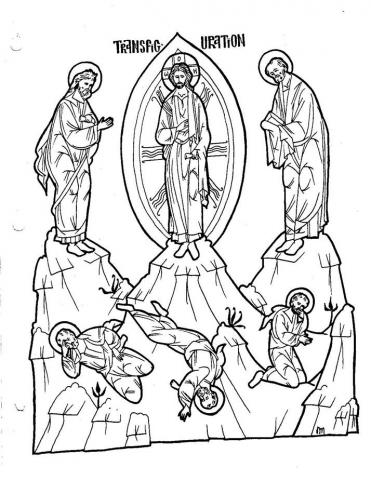
Good Samaritan
THE GOOD SAMARITAN
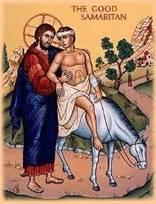 Objectives:
Objectives:
- Children should be able to identify this story as a parable of Jesus.
- Children should be able to tell the story in their own words.
- Children should have an understanding of what makes a good neighbor.
Possible Lesson Plan:
- Open with prayer. Use the Lord’s Prayer. Recite it a couple of times for memory practice.
- Read the story of the Good Samaritan in the Beginner’s Bible, pages 379-384, the Children’s Bible Reader, page 202, or the Read with Me Bible, pages 324-328. Supplement, if desired, with the Golden Children’s Bible, pages 412-413. Review the meaning of a parable, a story with a hidden meaning. Why did Jesus tell this story? What happened to the man in the story? Was the priest a good neighbor to this man? The Levite? Why or why not? Was the Samaritan man a good neighbor to the hurt man? Why?
- Feed the Elephant True/False Questions:
True False
The man was traveling to Jericho. The man was traveling to Bethlehem.
The man was hurt by robbers. The man had a safe and boring trip.
The priest passed the man without helping. The priest helped the man.
The Samaritan man helped the hurt man. The Samaritan hated the hurt man.
Add the Good Samaritan to your timeline:
- Discuss the concept of “neighbor”: Ask the children who are their neighbors. After a listing of friends and neighbors, try to expand their focus. Is the homeless man in the street who smells bad and is dirty also a neighbor? Is the child who steals their lunch money also a neighbor? Is the boy who hits them on the playground also a neighbor? Did Jewish people usually like Samaritans? Did Samaritans usually like Jewish people? Was it easy for this Samaritan man to care for the Jewish man? Is it always easy to love other people and to do good things for them? Is there someone you find particularly difficult to love? Can you do something nice for them as a good neighbor?
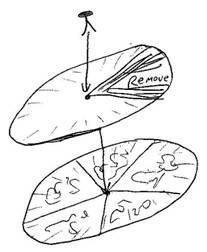 Make a Good Samaritan Story Wheel: Take 2 paper plates. Cut a wedge from one 1/5 of the circumference of the plate. Copy the figures on the next page and cut to fit the plate. Color in class and glue into the uncut plate. Attach the other plate with a brad. Now you can spin the opening, telling the story picture by picture. Practice in class, being sure each child can tell the story.
Make a Good Samaritan Story Wheel: Take 2 paper plates. Cut a wedge from one 1/5 of the circumference of the plate. Copy the figures on the next page and cut to fit the plate. Color in class and glue into the uncut plate. Attach the other plate with a brad. Now you can spin the opening, telling the story picture by picture. Practice in class, being sure each child can tell the story.
- Close with prayer. Have each child think of a particular person who is hard to love and pray for that person and plan something nice for that person.
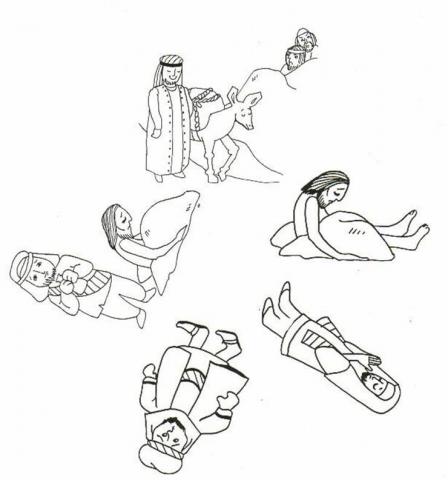
Parable of the Sower
PARABLE OF THE SOWER
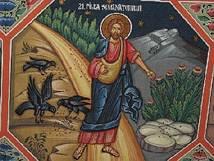 Objectives:
Objectives:
- Children should be able to tell the story of the parable in their own words.
- Children should know the word, “parable”, and be able to say that it is a story with a hidden meaning.
- Children should know the “hidden meaning” of the seeds and the sower.
Possible Lesson Plan:
- Open with prayer.
- Read the story of the sower in the Golden Children’s Bible, pages 392-393, and the really fun Arch book, “Seeds that Grew”. Tell the children that Jesus is telling a story. It is a special kind of story. It is called a parable. Repeat the word until the children know it. What is a parable? In this parable, who is the sower? What are the seeds? What is the soil?
- Feed the Elephant True/False Questions:
True False
A parable is a story with a hidden meaning. A parable is a comic strip.
The sower is Jesus or God. The sower is the devil.
The seeds are God’s words or teachings. We are the seeds.
We are the soil. God is the soil.
- Try to understand the parable a bit: What kind of people are hard, rocky ground? Would seeds grow well there? What kind of people are easily dried out by the hot sun? Would seeds grow well there? What kind of people are so shallow the birds can eat the seeds? What kind of things might be thorns that take over our lives? What kind of people are rich soil? What kind of people are each of us? This will be hard with smaller children; they may remain totally concrete, unable to see people as dirt and teachings as seeds. That’s OK; talk about seeds and dirt and later understanding will come.
Add the Sower to your timeline:
- Make a plant from the seeds and watch it grow! Take a small flowerpot for each child. Decorate the outside of the pot with lots of different kinds of seeds and beans: corn, split peas, lentils, red lentils, barley, etc. make a pretty combination. Apply glue in the pattern desired by the child and sprinkle on the seeds. Use LOTS OF GLUE! Fill with dirt. Plant a few flower seeds in each pot. Tell the children to water the pots as soon as they get home and to keep them in a window and watered. Soon the plants will grow!
- Close with prayer, asking Jesus to make us good soil to learn and obey His teachings.
Zaccheus
ZACCHEUS
Objectives:
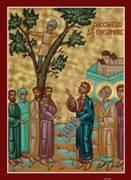 Children should be able to identify Zaccheus as the short man who wanted to see Jesus.
Children should be able to identify Zaccheus as the short man who wanted to see Jesus.- Children should know that Zaccheus’s life was changed by meeting Jesus.
Possible Lesson Plan:
- Open with prayer.
- Read the story of Zaccheus from the Beginner’s Bible, pages 413-417, the Children’s Bible Reader, page 224, or the Read with Me Bible, pages 356-357. Supplement with the Golden Children’s Bible, page 422, if desired. What did Zaccheus do for a living? Do we know another tax collector in the Bible? (Matthew, the disciple) Why couldn’t Zaccheus see Jesus? What did he do? What did Jesus say to Zaccheus? What did Zaccheus do for Jesus?
- Feed the Elephant True/False Questions:
True False
Zaccheus was a tax collector. Zaccheus was a priest.
Zaccheus was a short man. Zaccheus was the tallest man in town
Zaccheus climbed a tree. Zaccheus flew in a balloon.
Jesus went to Zaccheus’s house. Jesus walked right by Zaccheus.
Add Zaccheus to your timeline:
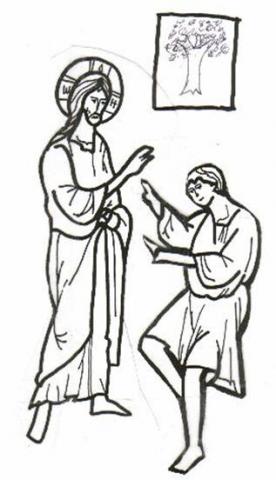
- Sing the song “Zaccheus was a wee little man…”
- Look around the room: Who is tall? Who is short? Who has blond hair? Who has dark hair? Who has blue eyes? Who has brown eyes? Have children brainstorm other physical characteristics that make us uniquely ourselves. Does God love only tall people? Brown-haired people? Blue-eyed people? God loves everyone! God loves each of us, just like we are!
- Make a Finger Paint Zaccheus Tree: Take a piece of white construction paper. Cut out a brown trunk for each child and let them glue the trunks on. Copy and cut out the Zaccheus and Jesus figures. Let the children color them. Add leaves to the tree with green finger paint and glue on Zaccheus in the tree and Jesus on the ground talking to him. Retell the story using the picture; be sure each child can tell it in his own words.
- Print the Pre-Lenten Path for the children to take home to color one square each day until Great Lent.
- Close with prayer.
Publican and Pharisee
THE PUBLICAN AND THE PHARISEE
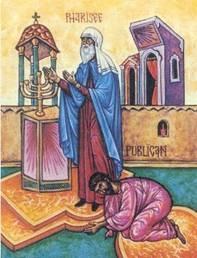
Objectives:
- Children should be able to say the words “publican” and “Pharisee” and know their meanings.
- Children should know whose prayers God listened to and why.
Possible Lesson Plan:
- Open with prayer.
Jesus told a story called a parable to the people. A parable is a story that teaches a lesson. This story is about two men who both went to the temple to pray. A temple is like a church. One of these was a Pharisee. Can you say “Pharisee”? A Pharisee was a man who spent his life studying the law of Moses and praying. He wore special clothes that told everyone he was a Pharisee. But this man came to the temple bragging to God about how good he was, and how wonderful were the things that he did, and how he wasn’t at all like other men. He stood tall with his own pride in all his deeds for God. His prayer was full of self-love, not love of God.
Another man was there. He was a Publican. Can you say “Publican”? A publican was a tax collector. In that day, some men collected taxes for the hated Romans and often stole some of the money for themselves. This man was sorry for his sins. He asked God to forgive him for his sins. He was so sad, he couldn’t even raise his head off the ground.
Jesus asked the people which prayer was heard by God? The Pharisee or the Publican? Of course, God would listen to the prayer of a holy man like the Pharisee, but not that of a hated tax collector. Jesus told the people that God honored the prayer of the tax collector who humbled himself before God and not the prayer of the Pharisee, full of pride and self-love
What is a publican? Who else have we met who is a tax collector? (Zaccheus and Matthew) Review their stories briefly. What did the publican pray? What is a Pharisee? (a respected man of the temple) What did he pray? Which did God listen to? Why?
- Read the story in the Zondervan Bible Storybook. Don't have it? Here's the story:
- Feed the Elephant True/False Questions:
True False
A publican is a tax collector. A publican is a teacher.
A Pharisee is a respected man of the temple. A Pharisee is a garbage collector.
God listened to the prayer of the publican. God listened to the Pharisee.
Add the Publican and the Pharisee to your timeline:
- Talk a bit about humility: How do you feel when you win a race? Get a prize? Do something good? This feeling is called pride. Some pride is OK. But the Pharisee had done many good things – so many good things that he was always bragging about himself, even to God! Do you ever brag when you do something good? How does it make you feel? How does it make other people feel? Do you feel like you’re better than other people? Does it look that way when you brag? Did the Pharisee think he was better than the publican? Was he in God’s eyes? Have you ever done anything wrong – ever disobeyed God or your parents, cheated in school, hit your brother, yelled at your sister, etc.? None of us is perfect; we all make mistakes. When we pray, should we brag, or should we ask God to help us obey Him even better? Remember the Beatitudes: can anyone recite “Blessed are the poor in spirit…”? Which was poor in spirit – the publican or the Pharisee? Which will inherit the kingdom of heaven?
- Make Publican and Pharisee dolls. See the pattern on the next page.
- Close with prayer. Try St. Ephraim’s Prayer, rehearsing complete with prostrations for upcoming Great Lent. Is this prayer like the Publican’s or the Pharisee’s?
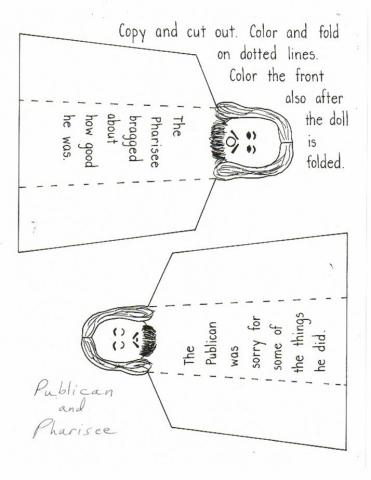
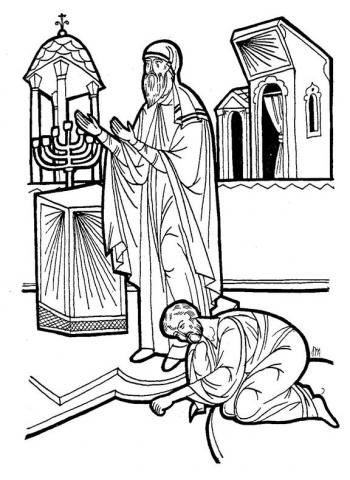
Prodigal Son
THE PRODIGAL SON
Objectives:
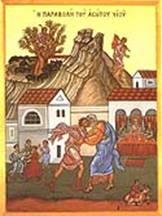 Children should be able to tell the story of the Prodigal Son in their own words.
Children should be able to tell the story of the Prodigal Son in their own words.- Children should know that God forgives us even when we do something we shouldn’t.
Possible Lesson Plan:
- Open with prayer.
- Read the story of the Prodigal Son in the Beginner’s Bible, pages 397-404, the Children’s Bible Reader, pages 207-209, or the Read with Me Bible, pages 344-349. Supplement with the Golden Children’s Bible, pages 416-417, if desired. Where did the son go? What did he do with his money? Where did he end up, doing what? Why did he go back to his father? What did he say? What did his father say?
- Feed the Elephant True/False Questions:
True False
The son left home with his money. The son stayed home with daddy.
The son spent all his money. The son saved his money carefully.
The son had to feed the pigs. The son worked in the market.
The father was happy the son came home. The father hated the son.
Add the Pig the Prodigal Son had to feed to your timeline:
- Talk a bit about the words “I’m sorry”: These are powerful words. When do we say them? Have the children think of some times they have said them or heard someone else say them. What do we mean by saying “I’m sorry”? Did the Prodigal Son say, “I’m sorry”? How did the father respond? How do we respond when someone says they are sorry? Sometimes it’s not so easy to forgive. What if your friend broke your favorite toy and said, “I’m sorry”? Is it easy to forgive when the toy is still broken?
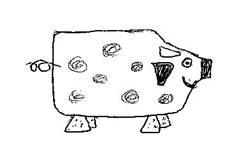 Make a Piggy Bank: The teacher should make one, too, for the class Piggy Bank. Take a gallon milk or juice plastic container. Turn it on its side so the handle is on top. Glue eyes just below the handle on both sides, 4 corks or bottle tops for feet, pink felt ears, and paper circles for spots all over the pig’s body. Twist a pipe-cleaner into a tail and poke it into the plastic behind. Draw on a mouth. Finally, cut a slit in the top for coins. All during Great Lent, we will each collect coins at home (from the sofa cushions, off the floor, by doing chores, etc.) and will bring them in to class to put in the class Piggy Bank to give to the IOCC at Pascha.
Make a Piggy Bank: The teacher should make one, too, for the class Piggy Bank. Take a gallon milk or juice plastic container. Turn it on its side so the handle is on top. Glue eyes just below the handle on both sides, 4 corks or bottle tops for feet, pink felt ears, and paper circles for spots all over the pig’s body. Twist a pipe-cleaner into a tail and poke it into the plastic behind. Draw on a mouth. Finally, cut a slit in the top for coins. All during Great Lent, we will each collect coins at home (from the sofa cushions, off the floor, by doing chores, etc.) and will bring them in to class to put in the class Piggy Bank to give to the IOCC at Pascha.
- Alternate Craft Idea: Paper bag pig. Use the templates on this page to glue on a paper bag (You can also use them as templates for your piggy bank). Write the verse on the bottom of the bag: “I shall arise and go unto my Father and shall say unto Him, ‘Father, I have sinned against heaven and before thee, and am no more worthy to be called thy son.’”
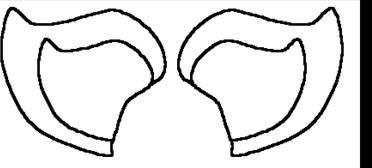
Ears
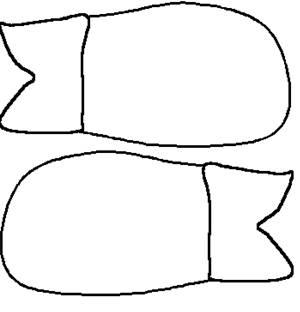
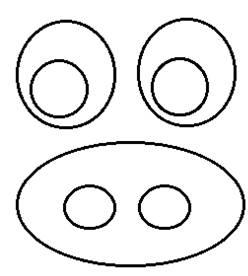
Eyes and nose Arms
- Close with prayer.
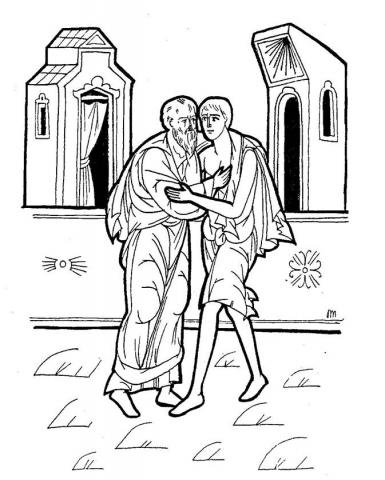
Last Judgment
THE LAST JUDGMENT
Objectives:
- Children should know that Jesus is coming again as judge.
- Children should be able to list some of the characteristics of goodness.
Possible Lesson Plan:
- Open with prayer.
2. Tell the parable of the Last Judgment: Jesus said, “When the Son of man comes, he will be like a king sitting on a throne. All around the throne will be angels and in front of the throne will be all the peoples of the earth. Then the King will judge the people. He will separate the good people from the bad people. He will have the good people stand on his right side and he will say to them, ‘ Come, O good children of my Father. Receive the beautiful Kingdom that God created for you in the beginning. You have lived as my Father wanted you to live, for when I was hungry, you gave me food to eat, when I was thirsty, you gave me something to drink, when I came as a stranger, you welcomed me, when I was naked, you clothed me, when I was sick, you visited me, when I was in prison, you came to see me.’ Then the people will answer the King: ‘ Lord, when did we see you and do all these things for you?’ And the King will answer, ‘If you were kind or helped anyone who needed help, you helped me. The good things you did to them, you did to me.’ Then the King will say to those at his left side, ‘Because you didn’t help anyone, or weren’t kind or generous to anyone, you didn’t show kindness to me.’ Therefore the King will send them away to be punished forever, but to the good people, he will give life forever in his kingdom.”
Add the Sheep and the Goat to your Timeline:
- Instead of True/False Questions, have the children try to list the characteristics of goodness, as stated in the parable. Discuss each one: Have we done any of these things? When? Have children tell stories from their own lives.
- Review some Old Testament stories of judgment: Adam and Eve and the Garden, Noah and the flood, Sodom and Gomorrah and Lot’s wife, Pharaoh and the plagues of Egypt, etc. Each of these can be looked at again in the Read with Me Bible.
- Make a clothespin sheep: print on cardstock, wrap body with yarn, glue head on body, decorate clothespins with markers, add cotton ball and wiggle eyes. Or, use a small plate and cotton balls for the body. No wiggle eyes? If the face is black, use the little adhesive circles sold to reinforce the holes in notebook paper. Write "We are His sheep" on the legs.
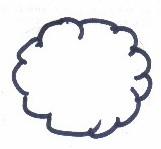 If this seems too difficult, try the marshmallow sheep following. Just attach a front and a back to a marshmallow (e.g. with sticky marshmallow crème) and stick toothpicks or black licorice in the marshmallow for legs. Write on the front “The good things you did for them” and on the back “You did for Me”.
If this seems too difficult, try the marshmallow sheep following. Just attach a front and a back to a marshmallow (e.g. with sticky marshmallow crème) and stick toothpicks or black licorice in the marshmallow for legs. Write on the front “The good things you did for them” and on the back “You did for Me”.
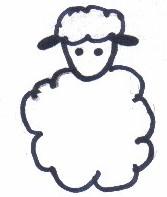
7. Close with prayer. Have each child specifically select a Last Judgment good deed to do this week.
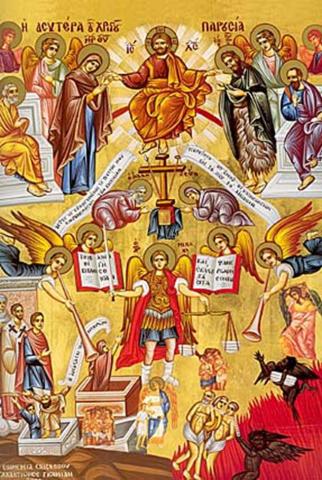
Forgiveness and the Paralytic
FORGIVENESS/ THE PARALYTIC
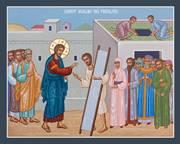 Objectives:
Objectives:
- Children should be able to tell the story of the paralytic and his four friends.
- Children should know that Jesus can forgive sins because He is God.
Possible Lesson Plan:
- Open with prayer.
- Read the story of the paralytic in the Beginner’s Bible, pages 328-333, the Children’s Bible Reader, page 187, or the Read with Me Bible, pages 3003-303. Supplement with the Golden Children’s Bible, page 370, or the Arch Book, “The Lame Man Who Walked,” if desired. What does “paralytic” mean? Where was Jesus? Where were the friends with the man? How did they get into the house? What did Jesus do? Say? What happened? How do you think the man felt? His friends?
- Feed the Elephant True/False Questions:
True False
The paralytic man could not walk. The paralytic man could not see.
There was a big crowd around Jesus. Jesus was all alone in the house.
The man’s friends cut a hole in the roof. The friends went in the window.
Jesus forgave the man’s sins. Jesus told the friends to carry the
Jesus healed the man and he could walk. man back home.
Add the Paralytic to your timeline:
- Talk a bit about disabilities: What would it be like to be a paralytic? Lie on the floor and pretend you can’t move your arms or legs at all. Can you walk? Can you eat? Can you brush your teeth? What would it be like to be blind? Close your eyes or turn out the lights. Pass around several familiar objects – a pencil, a crayon, a brush, a rubber band, etc. Can you identify them? What would it be like to be deaf? Try talking to each other by only moving the lips. Can you understand each other? Would you want to be healed?
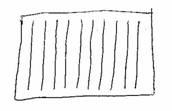 Who forgives sins? Jesus said something unusual to the paralytic before he healed him. What did He say? The Prodigal Son asked for forgiveness; did the paralytic? We all can forgive each other. Tonight, in church, we’ll be celebrating Forgiveness Sunday. We’ll go from one to another asking forgiveness and being forgiven. Demonstrate and practice with the class how to do the sign of the Cross and a bow and to ask forgiveness. But, only one person can forgive us all our sins. Who is that? When Jesus told the paralytic that his sins were forgiven, Jesus was claiming to be Whom? And, when the paralytic walked, Jesus proved that He was indeed God!
Who forgives sins? Jesus said something unusual to the paralytic before he healed him. What did He say? The Prodigal Son asked for forgiveness; did the paralytic? We all can forgive each other. Tonight, in church, we’ll be celebrating Forgiveness Sunday. We’ll go from one to another asking forgiveness and being forgiven. Demonstrate and practice with the class how to do the sign of the Cross and a bow and to ask forgiveness. But, only one person can forgive us all our sins. Who is that? When Jesus told the paralytic that his sins were forgiven, Jesus was claiming to be Whom? And, when the paralytic walked, Jesus proved that He was indeed God!- Make the Paralytic Man’s (Place)Mat: Take a piece of construction paper and cut slits vertically. Cut strips of a contrasting color of paper. Tape a strip down for the child and show him how to weave it in and out to the other end. Tape again. Repeat until the center is fully woven. Cover with Contac paper and use as a placemat. Can you tell the story from the mat’s point of view?
- We are now entering Lent. Use the Lenten Path to color your journey:
- Close with prayer.
Miracles and Healings
MIRACLES AND HEALINGS
Objectives:
- Children should be able to tell the story of at least one healing of Jesus.
- Children should know the word “miracle” and what it means.
- Children should know the importance of saying, “Thank you”.
Possible Lesson Plan:
- Open with prayer.
- Read the stories of Jesus’s healing miracles in the Beginner’s Bible, pages 340-350,371-374, 405-408, the Children’s Bible Reader, pages 188-189, 213, 221-222, or the Read with Me Bible, pages 308-311 and 350-353. Supplement especially with the Arch Book, “He Remembered to Say Thank You” or with the Golden Children’s Bible pages 369,372,373, 384, and 398. There are many, many healing miracles. Focus on two or three and have the children retell the stories, perhaps with the flannelgraph figures. What kinds of problems did Jesus heal? You may have to tell the children what leprosy is. What kinds of people did Jesus heal? Did He heal the same way each time? We’ll skip the True/False questions today in light of the large number of stories to cover.
Add the Miracles of Jesus to your timeline:
- Talk a bit about illness. Ask the children: Have you ever been sick? What’s it like to be sick? Are there different kinds of sickness? Be prepared for them to launch into descriptions of their own pain and suffering. Is it fun being sick? What do we do when we are sick? (Go to the doctor, take medicine, stay in bed, etc.) What did Jesus do when someone came to Him who was sick? (He prayed for them and they got better.) Can we pray to Jesus, too? Can we ask Jesus to help us, too? What do we say to Jesus after asking Him to help us? (Thank you.) The Church has a special sacrament where we pray to Jesus for healing. It is called “Holy Unction.” Have the children repeat the words until they know them. We should call the priest and pray to Jesus whenever we are very sick.
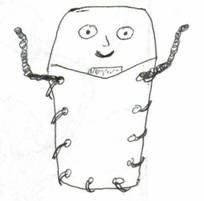 Make Get Well Cards. Fold construction paper into card shapes. Write Get Well on each. Have children decorate several each – stickers, crayons, paints, whatever. Donate these to the parish council representative in charge of visiting the sick and sending cards.
Make Get Well Cards. Fold construction paper into card shapes. Write Get Well on each. Have children decorate several each – stickers, crayons, paints, whatever. Donate these to the parish council representative in charge of visiting the sick and sending cards.
- Alternate Craft: Band-Aid Holder: Cut two pieces of foam; remove the top part of the front piece. Punch holes ahead of time and attach piece of yarn; let children lace front and back together. Stick chenille arms thru top holes; glue on wiggle eyes and draw face. Attach a piece of adhesive magnetic tape on the back and fill with band-aids to have handy on the refrigerator.
- Close with prayer, praying especially for anyone known by a student to be sick.
Lazarus
THE RAISING OF LAZARUS
Objectives:
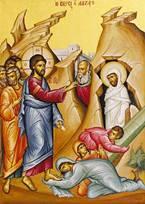 Children should be able to tell the story of Lazarus in their own words.
Children should be able to tell the story of Lazarus in their own words.- Children should know the names of Mary, Martha, and Lazarus.
Possible Lesson Plan:
- Open with prayer.
- Read the story of the raising of Lazarus in the Beginner’s Bible, pages 418-422, the Children’s Bible Reader, pages 227-229, or the Read with Me Bible, pages 329-339. Supplement, if desired, with the Golden Children’s Bible, pages 423-425. Where was Jesus when Lazarus became sick? Who were the sisters of Lazarus? How was Lazarus by the time Jesus came? What did Jesus do? Why did Jesus cry? What happened to Lazarus after Jesus prayed? Review the story with the icon, identifying Jesus, Lazarus, Peter, and the sister.
- Feed the Elephant True/False Questions:
True False
Mary liked to sit at Jesus’s feet. Martha sat and listened to Jesus.
Martha was very busy getting things done. Mary was busy getting things done.
Lazarus was very sick and died. Lazarus had a little cold.
Mary and Martha were Lazarus’s sisters. Elizabeth and Anna were Lazarus’s sisters.
Jesus told Lazarus to come out. Jesus told Lazarus to take a bath.
Add Lazarus to your timeline:
- Play-act the story with one student wrapped like Lazarus in toilet paper. Another student plays Jesus, with students as Mary and Martha and the disciples watching. Jesus prays and shouts, “Lazarus, come forth!” Lazarus enters the room. Jesus tells the others to untie him and the toilet paper is unwrapped.
- Discuss death a bit: What is death? Have the children ever known anyone who has died? Why are we sad when someone dies? Mary and Martha knew that Lazarus would rise again someday, but they were still sad. They would miss their brother. Even Jesus cried. Remind the children that Jesus knew that He would also soon die. Is Jesus stronger than even death? (Yes) How did He prove this even before He Himself rose from the dead?
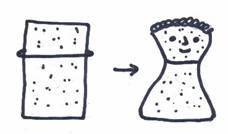 Make a Sponge Puppet Mummy: Take a pink or white kitchen sponge, unusued. Use a rubber band to separate head from body. Draw on face and attach hair, etc. if desired. Cut two holes in middle of sponge to stick fingers out to be arms. Give each child a long piece of toilet paper or gauze and wrap Lazarus like a mummy. Can everyone tell the story of Lazarus? Act out with puppets, rising up and taking off the wrappings. You can do exactly the same thing with craft sticks or toilet paper tubes if you are short on sponges.
Make a Sponge Puppet Mummy: Take a pink or white kitchen sponge, unusued. Use a rubber band to separate head from body. Draw on face and attach hair, etc. if desired. Cut two holes in middle of sponge to stick fingers out to be arms. Give each child a long piece of toilet paper or gauze and wrap Lazarus like a mummy. Can everyone tell the story of Lazarus? Act out with puppets, rising up and taking off the wrappings. You can do exactly the same thing with craft sticks or toilet paper tubes if you are short on sponges.
7. Alternate craft idea: Print on cardstock the Lazarus Come Forth full page size, stone with flap sized to match PLUS Jesus and Lazarus from the icon coloring page. Color Jesus and Lazarus and cut them out; cut out the stone, with the flap. Glue Lazarus in the tomb and Jesus to the side of the opening. Tape flap on bottom and children can “remove” the stone to reveal Lazarus.
- 8. Begin the “Path of Lent” by printing the sheet for each child, plus one for the class, and color in the days already past. Children can take home and color in one day as each passes. This is adapted from the Catholic Icing website to include the Orthodox weeks and feasts. Write in the fixed feast of Annunciation on March 25 as it falls in this year.
9. Little children love Easter eggs, right? Begin your set of "Resurrection Eggs" today with an empty egg carton, one plastic egg, and put in it a band-aid or a piece of gauze to represent Lazarus. There's a set of paper egg fillers if you'd prefer, although, for the small children, the visual and tactile different eggs would be even more fun. Do you remember why we dye eggs red at Pascha? Yes, remind them of the story of Mary Magdalene and her egg that turned red right in front of the Roman Emperor!
10. Close with prayer.
Palm Sunday
PALM SUNDAY
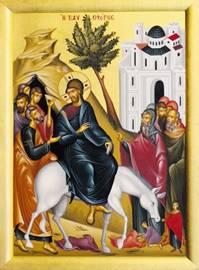
Objectives:
- Children should know that Palm Sunday celebrates Jesus’s triumphal entry into Jerusalem.
- They should be able to identify the characters in the icon and tell the story.
Possible Lesson Plan:
- Open with prayer.
- Read the story of Palm Sunday in the Beginner’s Bible, pages 427-432, the Children’s Bible Reader, pages 230-232, or the Read with Me Bible, pages 358-361. Supplement with the Golden Children’s Bible, pages 428-430, or the Arch book, The Donkey Who Served the King. Use the icon and point out the characters and their roles. How did Jesus get the donkey? What were the people doing? What were they saying? Are there children?
- True or False:
True False
Jesus entered Jerusalem on a donkey. Jesus entered Jerusalem on an elephant.
The people were happy to see Jesus. The people shouted, “Crucify him!”
The people shouted “Hosanna!” The disciples stole the donkey.
The children waved palm branches. Jesus entered Rome on Palm Sunday.
People made a carpet for Jesus with People threw rocks at Jesus.
with their coats.
Add Palm Sunday to your timeline:
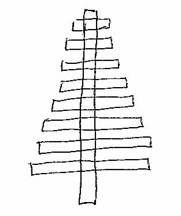
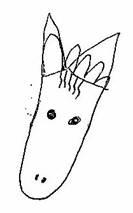 Show pictures of palm trees. If you have them, show the children a palm branch and a pussy willow. Let them hold and touch.
Show pictures of palm trees. If you have them, show the children a palm branch and a pussy willow. Let them hold and touch.
- Make a Footprint Donkey and a Palm Branch. Using brown construction paper, trace around each child’s foot (OK in shoes) and elongate the toes to shape like ears. Cut out and add eyes, nose, and yarn for forelock. Then, cut green construction paper into varying-length strips and staple onto a posterboard (black, brown, or green) stem to make a palm leaf.
- March around the room waving the palm branches and throwing coats on the floor, shouting over and over, “Hosanna in the Highest! Blessed is He who comes in the name of the Lord!”
7. Add the 2nd egg to your egg carton of Resurrection Eggs with a leaf.
8. Close with prayer.
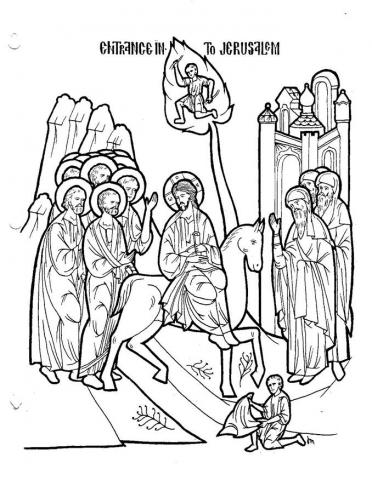
Last Supper
THE LAST SUPPER
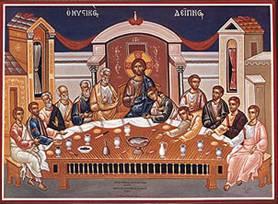 Objectives:
Objectives:
- Children should be able to tell the story of the Last Supper in their own words.
- Children should identify the major figures in the icon.
- Children should know that the Last Supper was also the first Communion.
- Children should be able to name bread and wine as the Communion foods.
Possible Lesson Plan:
- Open with prayer.
- Read the story of the Last Supper in the Beginner’s Bible, pages 437-445, the Children’s Bible Reader, pages 236-242, or the Read with Me Bible, pages 366-381. Supplement with the Golden Children’s Bible, pages 440-447, if desired. What did Jesus wash before supper? Why? What foods did He bless? Who was going to betray Him? Review the story with the icon, identifying the characters, the bread, and the wine. We celebrate the Last Supper on Holy Thursday with the 12 readings of the story.
- Feed the Elephant True/False Questions:
True False
Jesus washed his disciples’ feet. Jesus washed his hair.
Jesus blessed the bread and wine. Jesus blessed the broccoli.
Judas Iscariot went to betray Jesus. Peter went to betray Jesus.
Jesus prayed in the Garden of Gethsemane. Jesus danced a jig in the garden.
The disciples fell asleep. The disciples prayed with Jesus.
Judas kissed Jesus to betray Him. Judas cut off Jesus’s ear.
Add the Last Supper to your timeline:
- Review the story of Moses and Passover in the Read with Me Bible. Jesus and His disciples were celebrating Passover dinner at the time of the Last Supper. In fact, Jesus is called the Paschal lamb. How is He like the Passover lamb? The lamb saved God’s people from death, just as Jesus was soon to save all people from death.
- Have a foot-washing: Have the children sit in a circle with shoes off. Take turns washing each others feet.
- Talk a bit about Holy Communion: What do we eat and drink for Holy Communion? Why are these foods special? When was the first Communion? Role-play with smaller children how to properly take communion: Show them how to cross their arms, open the mouth, kiss the chalice, and cross themselves. Practice while singing:
This is the way we hold our hands, hold our hands…
This is the way we open our mouths, open our mouths…
This is the way we kiss the chalice, kiss the chalice…
This is the way we cross ourselves, cross ourselves…
7. Make a Communion Mobile. Glue the picture onto a paper plate and decorate the rim in a creative way. Color the icon and cut it out paper-plate size. Glue on the back. Punch hole at top. Attach string so it can spin; remind the children that Holy Communion was begun at the Last Supper.
8. Today, you can add 3 eggs to the Resurrection Egg Carton: a piece of washcloth or spongs for the foot washing, a silver coin for Judas's betrayal, and a grape and/or bread for the supper itself.
9. Close with prayer.
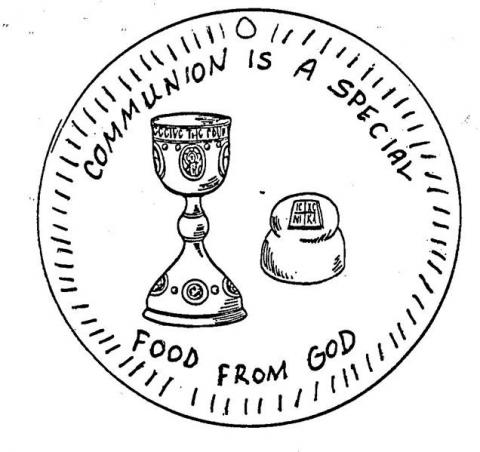
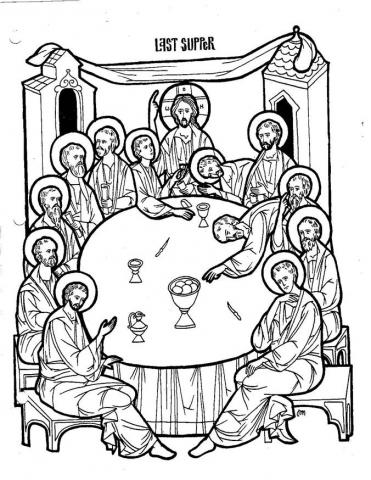
T
Crucifixion
THE CRUCIFIXION
Objectives: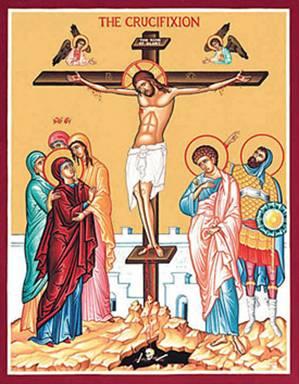
- Children should be able to say the word “crucifixion” and know that it means to be nailed to a cross.
- Children should know the story of Jesus’s crucifixion and be able to tell it.
- Children should be able to identify the characters in the icon and their meaning.
Possible Lesson Plan:
- Open with prayer.
- Read the story of Jesus’s arrest, trial, crucifixion, and burial in the Beginner’s Bible, pages 437-445, the Children’s Bible Reader, pages 242-255, or the Read with Me Bible, pages 382-397. Supplement with the Golden Children’s Bible, pages 448-455, if desired, or the Arch book, “The Man Who Carried the Cross for Jesus”. Where was Jesus when He was arrested? What was He doing? What were the disciples doing? How did Judas betray Him? Peter lied about knowing Jesus how many times? Before when? Who was the high priest? The soldiers put what on Jesus? Who condemned Jesus to death? How did He die? Who carried the cross? Why? What are some of the things Jesus said on the cross before He died? Who was crucified with Jesus? What happened when Jesus died? Who took Jesus’s body to his own tomb? Review the story with the icon, identifying the people. What role did each play?
3. Feed the Elephant True/False Questions:
True False
Jesus was arrested in the Garden of Gethsemane. Jesus was arrested at home.
Judas betrayed Jesus with a kiss. Judas hit Jesus with a sword.
Peter denied knowing Jesus 3 times. Peter denied Jesus 20 times.
The soldiers put a crown of thorns on Jesus. The soldiers gave Jesus gold.
Pontius Pilate judged Jesus. Moses judged Jesus.
Joseph of Arimathea buried Jesus. Pilate buried Jesus.
Add the cross to your timeline:
- We celebrate the Crucifixion on Holy Friday. We sing on Thursday about the “Wise Thief”. The story is in the Children’s Bible, page 353, or the Arch book “The Thief Who Was Sorry”. Which thief was wise and why? We also sing on Friday about “The Noble Joseph”. Who was the noble Joseph? What did he do? Play these beautiful songs if you want with tape or CD from the bookstore. Do you remember what we do in Church on Holy Friday? (Procession, candles, the tomb.)
- The Cross is the symbol of the Crucifixion. Practice making the sign of the Cross until each child can do it correctly. Role play the prostrations while singing the song “Before Thy Cross”.
- Make a time line, written with readers, in pictures with small fry. Draw on it the events of Holy Week from Lazarus Saturday until Pascha, filling in each detail the children remember and jogging their memories if needed.
- Make Jesus on the cross. Print on cardstock the crosses and cut on dotted lines, folding back side sections. It will now stand up. Print the figure of Jesus and cut out ahead of time. Children color Jesus and the background. Glue Jesus onto the background. Save time by using the colored Jesus from the icon and just coloring the background.
- Want something more involved that tells the whole story and have plenty of time? Try doing fingerpainting for the story of Holy Week in Handprints. You’ll need lots of pieces of paper, printed ahead of time, and colors of fingerpaint, and shoes off to do outside, but the kids will have a ball making them and the books will be ready to staple together after drying. The pages start on the next page. The very light hands and feet are just to give you an idea where to put the fingerpainted items. There are also pages for Resurrection, Holy Myrrh-bearers, and Road to Emmaeus to use for the lessons coming up. These patterns come from Catholic Icing, a lovely website.
- Need something really simple but still telling the whole story? Have each child color one or two figures from the toilet paper tube scene, glue to the toilet paper tubes, cut out the tomb entrance and glue to tissue box, put the stone table inside. Now act out the crucifixion and next week the resurrection with your class figures.
- Add several eggs to your Resurrection Eggs today, reviewing the ones already in the carton: Include praying hands for Jesus praying in the Garden of Gethsemane (or an olive for the olive trees of the garden), a thorn (perhaps from a rose bush) for the crown of thorns, a small piece of leather for a whip, a feather for the rooster and Peter’s denial, a nail, 3 crosses, a die for the soldiers playing dice for His robe, a spear, and a stone for the stone rolled across the tomb. OK? More than 12? Be sure to NOT include any that you did not cover in your story lesson, like perhaps the dice. Even so, you may need to put a couple of eggs on top of the carton or start a new carton.
- Close with prayer.
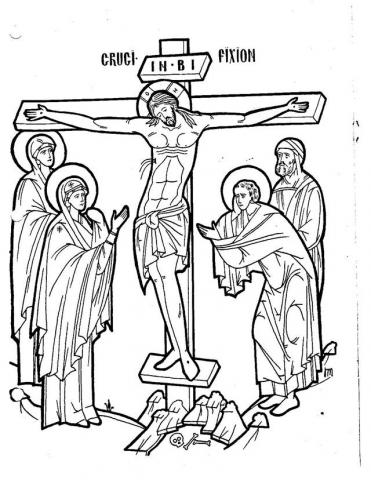
Pascha
PASCHA
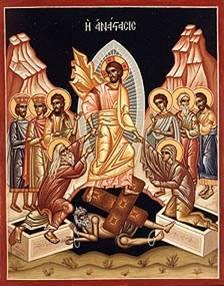 Objectives:
Objectives:
- Children should know the Paschal greeting and response, in as many languages as possible.
- Children should know that on Pascha we celebrate Jesus rising from the dead.
- Children should recognize the icon and the figures in it.
Possible Lesson Plan:
- Open with prayer: Teach and sing the hymn, “Christ is risen from the dead, trampling down death by death; and upon those in the tombs bestowing life!”
- Read the story of Palm Sunday in the Beginner’s Bible, pages 453-458, the Children’s Bible Reader, pages 257-258, or the Read with Me Bible, pages 398-399. Supplement with the Golden Children’s Bible, pages 356-358, if desired. Who came to the tomb? Why are we so happy on Pascha? Use the icon to retell the story, pointing out each character. Review the stories of Adam and Even, of John the Baptist. You can also read on of the Arch books, either “Kiri and the first Easter” or “The Glory Story.”
- True or False?
True False
Jesus rose from the dead on Pascha. Jesus rose from the dead on Palm Sunday.
Judas Iscariot betrayed Jesus. Jesus was crucified on Pascha.
Jesus was crucified on Holy Friday. Caiphas, the high priest, loved Jesus.
Two Marys went to the tomb. Mary and Mary saw a snake in the tomb.
The noble Joseph of Arimathea Peter never denied he knew Jesus.
buried Jesus’s body.
Add Resurrection to your timeline:
- Teach the Paschal greeting in several languages; the children can respond.
English: Christ is risen! Indeed He is risen!
Greek: Christos anesti! Alethos anesti!
Russian: Christos voskrese! Voistinue voskrese!
Arabic: Al-masi-kam! Haq an qaam!
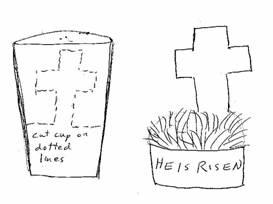
- Make an Easter Planter. Cut the outline out of a Styrofoam cup as in the picture. The children can color the outside of their cup, if desired. Write the words, Christ is Risen, on each cup with permanent marker. Fill cups with dirt. Sprinkle with grass seed. Tell the children to water as soon as they get home. The grass will actually come up even by next week!
- Last egg for the Resurrection Eggs -- empty, of course.
- Close again with the song and a prayer
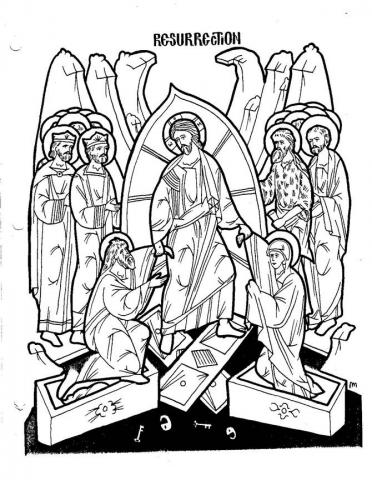
Doubting Thomas
DOUBTING THOMAS
Objectives:
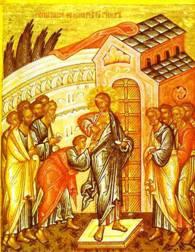 Children should recognize the name of Thomas as a disciple.
Children should recognize the name of Thomas as a disciple.- Children should be able to tell the story of Thomas in their own words.
Possible Lesson Plan:
- Open with prayer.
- Read the story of Thomas in the Children’s Bible Reader, pages 261-263, or the Children’s Bible, page 458, or Children’s Stories of the Bible page 244, or use the Arch book, “Doubting Thomas”.Who was Thomas? What happened to the other disciples? Was Thomas there? What did Thomas say? What did Jesus do? How did Thomas respond? Why is he known as “Doubting Thomas”?
- Feed the Elephant True/False Questions:
True False
Thomas was a disciple. Thomas was a thief.
Thomas didn’t believe the other disciples. Thomas saw Jesus before anyone.
Jesus appeared also to Thomas. Thomas never saw Jesus.
Thomas bowed and worshipped Jesus. Thomas ran away from Jesus.
Add Doubting Thomas to your timeline:
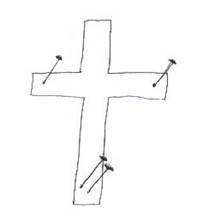 Talk a bit about doubt: Has someone ever told you something that was hard to believe? Listen to the children’s stories of things they would find hard to believe. If someone told you he saw a dead man walking around, would that be hard to believe? Did Thomas believe the other disciples? Would you? Talk a bit about the normal, expected way things usually are: Can the children describe some things that we know should happen in a certain way or look a certain way? Maybe, things fall down, not up; we walk on our feet and not our heads; leaves are green and not purple. Life is full of normal, everyday things and it would be impossible to live life otherwise. Imagine a world where things fell up, down, or sideways at random, where …(go on with your children’s list). But, do things always have to be normal? Is God in charge? Can He change anything He wants when He needs to? So He can and did change death, and surprised poor Thomas.
Talk a bit about doubt: Has someone ever told you something that was hard to believe? Listen to the children’s stories of things they would find hard to believe. If someone told you he saw a dead man walking around, would that be hard to believe? Did Thomas believe the other disciples? Would you? Talk a bit about the normal, expected way things usually are: Can the children describe some things that we know should happen in a certain way or look a certain way? Maybe, things fall down, not up; we walk on our feet and not our heads; leaves are green and not purple. Life is full of normal, everyday things and it would be impossible to live life otherwise. Imagine a world where things fell up, down, or sideways at random, where …(go on with your children’s list). But, do things always have to be normal? Is God in charge? Can He change anything He wants when He needs to? So He can and did change death, and surprised poor Thomas.- Begin your Paschal Season Story Bags. Bring a tote bag to class; label it Paschal Season Stories. Put in it an empty Easter egg for the Empty Tomb, along with a glove to remind children that Thomas said he must see Jesus’ hands and feet. Keep the bag in the classroom and each week until Pentecost have the children take turns removing an item from the bag. Can the class tell the story to the teacher?
6. Make a Nailed Cross: Take a wooden cross, found at any craft shop, one for each child. This can also be done with Styrofoam. Spray paint it ahead of time; or let the children paint it. We have lots of hammers and nails. Let them hammer nails in; suggest the hands and feet position, but likely you’ll find nails everywhere. Remind them that Jesus showed Thomas the prints of the nails.
No nails or children a bit to young for hammer and nails? Why not take a piece of construction paper. Have children trace their hands and cut out. Glue to the construction paper and color a red circle in each one on the palm. Add the exclamation of Thomas, "My Lord and my God".
7. Close with prayer.
Myrrh-bearing Women
THE MYRRH-BEARING WOMEN
 Objectives:
Objectives:
- Students should be able to say the word “myrrh” and know its meaning.
- Students should be able to tell the story of the myrrh-bearing women in their own words.
Possible Lesson Plan:
- Open with prayer.
- Read the story of the myrrh-bearing women in the Beginner’s Bible, pages 456-458, the Children’s Bible Reader, page 257, or the Read with Me Bible, pages 398-399. Supplement with the Golden Children’s Bible, pages 354-356, if desired. There is also an Arch book, “The Easter Women”. Why were women going to the tomb? Why on Sunday? What is myrrh? What did they find? What did they do?
- Feed the Elephant True/False Questions:
True False
The women went to the tomb on Sunday. The women went on Saturday.
The women carried myrrh. The women carried wine.
They found the tomb empty. They found Jesus’s body.
They told the disciples Jesus was risen. They cried and fell asleep.
Add the Myrrh-Bearing Women to your timeline:
4. Add your sample sachet, made below, to your Pascha story bag, along with a red egg for Mary Magdalene, discussed at the Opening Exercises. Can the children recognize the other items in the bag and tell their stories?
5. Discuss a bit burial customs. Have any of the children been to a funeral or vigil? What are our customs? See if the children can remember singing “Memory Eternal” or eating koliva. The Jewish custom was to rub the body with myrrh. Why couldn’t the women do it Friday night? (the Sabbath) Where do we go to visit someone who has died? (cemetery) Where was Jesus’s body put after He died? Can you remember whose tomb it was? We usually bury people in the ground and fill the grave with dirt. How was the tomb of Jesus sealed? (stone) How did the women feel when the stone was rolled away? How would you feel if the grave of a loved one were found dug up? But, Jesus’s body wasn’t stolen; He told the women He had risen from the dead! How did they feel now? What did they do?
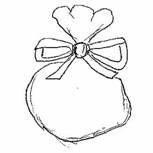 6. Make Sachets: Take a small circle of fabric or tulle for each child – or several? Fill each with spices – cinnamon, cloves, etc. Tie with ribbon or yarn. Give to mom for Mother’s Day to put in her drawers. Remind the children that the myrrh-bearing women brought sweet-smelling spices for Jesus. Can they tell the story?
6. Make Sachets: Take a small circle of fabric or tulle for each child – or several? Fill each with spices – cinnamon, cloves, etc. Tie with ribbon or yarn. Give to mom for Mother’s Day to put in her drawers. Remind the children that the myrrh-bearing women brought sweet-smelling spices for Jesus. Can they tell the story?
7. Close with prayer.
Road to Emmaeus
THE ROAD TO EMMAEUS
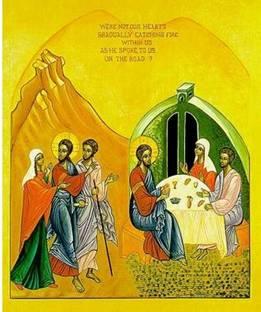 Objectives:
Objectives:
- Children should be able to tell the story of the road to Emmaeus in their own words.
- Children should know that the disciples recognized Jesus in the breaking of the bread.
Possible Lesson Plan:
- Open with prayer.
- Read the story of the Road to Emmaeus in the Children’s Bible Reader, pages 259-260, or the Golden Children’s Bible, pages 356-358. Where were the men going? Why? Who was the stranger? When did they know that He was Jesus? Review the story of the Last Supper, when Jesus last broke bread with His disciples.
- Feed the Elephant True/False Questions:
True False
The men were going to Emmaeus. The men were going to Nazareth.
They met Jesus on the way. They met John the Baptist.
Jesus told them all about the Bible. Jesus told them “The Three Pigs”.
They knew Jesus when He broke bread. They never knew who Jesus was.
Add the Road to Emmaeus to your timeline:
4. Add a flip flop to your Pascha Story Bag for the Road to Emmaeus, or some pretend bread or both, plus a plastic fish for the Appearance to the Fishermen discussed at Opening Exercises. Again review the contents of the bag with the children. No plastic fish? Make a “Jesus Fish” from a pipe cleaner.
5. This is a good time to review, as Jesus did, the span of the Old Testament and prophets and what they said about the Messiah. When did people first disobey God? Review the story of Adam and Eve. Over and over, God saved His people: Noah and the ark, Abraham and Isaac, Moses and Passover, Jonah and the big fish, the three boys in the fire, Daniel in the lion’s den. Look at the pictures in the Read with Me Bible. In each case, God provided the means of saving His people. What were they? (ark, ram, blood of lamb, fish, Jesus Himself, an angel) He gave His people His law, the Ten Commandments, but they disobeyed even that. Now He has given His Son to save us all!
6. Re-enact the scene as the men broke bread with Jesus. Have the students sit in a circle. Have some really tasty bread, with butter and jam ready. Remember to pray before eating. The teacher then can tear off a piece of bread for each student and everyone can eat the bread with butter and jam.
7. Make Prosphora in class. Tell the students that this is the bread that Father uses for Communion. It would be best to mix the dough at home:
3 cups warm water Mix warm water and yeast first
2 tablespoons fast rise yeast
5 pounds bread flour Add flour, salt, and cool water and knead
3 cups cool water
1 ½ tablespoons salt
Let the dough rise during Liturgy in the kitchen (not in oven). Divide into a loaf for each child and let the children knead and shape the loaves and stamp them. Take them home again to bake. Help each child to make a list of relatives, living and dead, for Father to pray for.
8. Make a plaster footprint. Take a paper plate for each child. Mix plaster of Paris, pour into plates, and allow to thicken till it’s like dough. Have children take off their shoes and each can step in the plaster on his plate, making a footprint. Clean their feet and put shoes back on. Remind the children that the men were traveling by foot to Emmaeus when Jesus appeared to them. By now, the plaster’s already nearly set. Let the children paint only the part that is not the footprint. Before the plaster completely dries, poke a hole about ½ inch from the top. Write the child’s name above the footprint in black permanent marker, and “Follower of Jesus” below. Next week, when the casts are fully dry, remove the plates and tie a ribbon through the hole. This would make a nice Father’s Day gift next month.
9. Close with prayer.
Ascension
ASCENSION
Objectives:
- Children should be able to say “Ascension” and define it.
- Children should identify the characters in the icon and tell the story.
Possible Lesson Plan:
- Open with prayer. Remember especially Pascha and the Paschal hymns and greetings.
- Read the story of the Ascension in the Beginner’s Bible, pages 466-472, the Children’s Bible Reader, page 267, or the Read with Me Bible, pages 402-403. Supplement with the Golden Children’s Bible, page 361, if desired. Use the icon as a visual aid and identify the people as you tell the story. There is Jesus, Mary, angels, and disciples. Can the children name the disciples? Which disciple is missing and why? (Judas Iscariot: The icon has St. Paul, but we haven’t studied him yet) Can all the students identify the people and tell the story?
- Feed the Elephant True/False Questions:
True False
Jesus rose into heaven on Ascension. Jesus died on the cross on Ascension
Mary and the disciples were there. Noah rode him to heaven on an ark.
Jesus told the people that He would Jesus told everyone He hated them.
always be with them.
Jesus is still alive in heaven Jesus is dead and gone.
Jesus told his disciples to wait in Jesus told his disciples to go home
Jerusalem. and go fishing.
Add Ascension to your timeline:
4. Pascha Story Bag is almost full now: Add a tiny globe (like a keychain globe, or use a light green tiny ball and color in the oceans with a blue Sharpie ahead of time) for the “Great Commission” and a cotton ball for the clouds into which Jesus ascended. Include a pair of dice for the choosing of Matthias discussed at Opening Exercises.
5. Was this a sad or a happy story? What did Jesus promise? (That He would always be with us.) Why are Jesus’s hands spread? (He’s blessing us.) What did He tell His followers to do? (To go to Jerusalem and wait for a helper from God.) Where is Jesus now? (in heaven)
6. Discuss the butterfly. Use pictures from the library or the encyclopedia. Show the caterpillar, the cocoon, and then the butterfly. Let the children crawl on the floor for a few minutes like caterpillars, then curl up very tight and still like cocoons, then leap up and fly like butterflies. Is this the same individual – the caterpillar, the cocoon, and the butterfly? So Jesus was born as a man, died, and rose into heaven – each a different form but the same God.
7. Make rising Jesus: Take a light blue paper cup and have children glue cotton balls to the outside like clouds. Then have them color the picture of Jesus, printed on heavy paper right from the icon, sized appropriately for your printer. Have hole punched in center top of cup and a string for each child about 18 inches long inserted thru the hole. Tie Jesus to the bottom of the string, hold at the top, and watch him rise into the clouds of the sky!
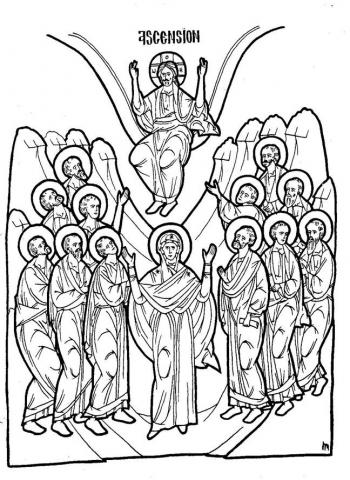 Close with prayer.
Close with prayer.

Pentecost
PENTECOST
Objectives:
- Children should be able to say the word “Pentecost” and know that this feast is the birthday of the Church.
- Children should know that the Holy Spirit descended on Pentecost.
- Children should be able to identify the characters in the icon and tell the story.
Possible Lesson Plan:
- Open with prayer.
- Read the story of Pentecost in the Beginner’s Bible, pages 473-479, the Children’s Bible Reader, pages 268-269, or the Read with Me Bible, pages 404-407. Use the Golden Children’s Bible, pages 362-363, as a supplement, if desired. Use the icon as a storytelling aid, identifying the characters and their roles. Who’s the little person in the center? (He represents the whole world.) Think a bit about the whole world – all the different peoples and customs. If you have pictures or dolls of people from around the world, show them now. Do they all dress alike? Look alike? But God sent His Spirit to all of us.
- Feed the Elephant True/False Questions:
True False
The Holy Spirit came down on Pentecost Jesus was born on Pentecost.
Mary and the disciples were in Jerusalem. Pentecost happened in Rome.
Tongues of fire appeared over the heads. Elephants appeared over their heads.
A great wind filled the room. The roof leaked and rain poured in.
The disciples spoke in many languages. The disciples crawled off and hid.
Add Pentecost to your timeline:
- Try just a bit on the Holy Spirit: Can we see the wind? Can we see what it does? Turn on a fan and watch their hair blow, pieces of paper move, etc. Can something invisible be very strong? When is the wind very strong? (tornado, hurricane, etc.) The Holy Spirit is like the wind. We cannot see it, but we can feel it. It is very strong. It is all around us and in us. So when the Holy Spirit came, the disciples could not see it, but they felt it and could hear it blowing and it changed their lives. The day when the Holy Spirit came down is called Pentecost; practice the word. When did each of us receive the Holy Spirit? (Chrismation). Try gluing strips of flame-colored paper to a longer strip and use a blow dryer to show the wind and the flames of Pentecost.
- We’ve now met all the Persons of the Trinity. This is a mystical concept, confusing to even adults. But let’s discuss it briefly. Practice making the sign of the cross and saying “in the name of the Father, of the Son, and of the Holy Spirit.” Who is the Father? Remind the children of the Lord’s Prayer; say it together. Who is the Son? (Jesus) Who is the Holy Spirit?
- The Church was born on Pentecost. Even though Jesus had risen from the dead, the disciples were still frightened and didn’t know what to do. After the coming of the Holy Spirit, the disciples could speak many languages and they were no longer afraid. They went all over the world, telling people about Jesus. What did some of the disciples do after Pentecost? (wrote gospels, traveled to far lands, baptized people, died for Christ) Have a Birthday Party for the Church, complete with cake and candles. How old is the Church?
- Make “Pentecost People”: Take some really huge pieces of paper – bulletin board paper, for example. Or brown wrapping paper. Have each child lie down on the paper and trace around his body. Allow the child to color himself and use yarn for hair. Don’t forget some clothes! Make flames from construction paper and glue above each child’s head. Remind the children that while the apostles received the Holy Spirit with tongues of fire, they, too, have the Holy Spirit. The fire above their heads symbolizes this.
- Too difficult or time-consuming? Try dove fans. Remind the children how the Holy Spirit had appeared at the baptism of the Lord as a dove. Remind them about the rushing wind at Pentecost. THen print a dove on paper, color it if desired, and fold into a fan, stapling at one end. Fan yourselves and feel the invisible wind.
- Close with prayer. Sing or recite “O Heavenly King”.
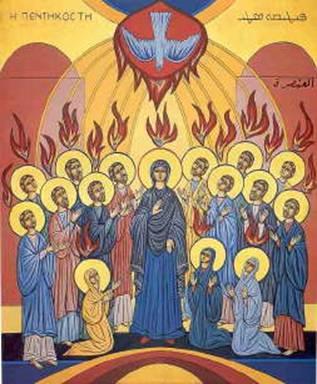
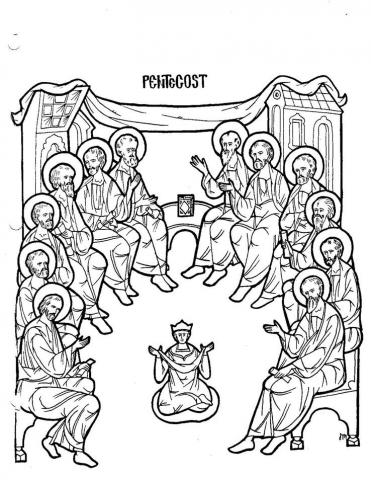
Lord's Prayer
THE LORD’S PRAYER
Objectives:
- Children should identify the Lord’s Prayer, or “Our Father”, as the prayer that Jesus taught His disciples.
- Children should memorize the Lord’s Prayer.
Possible Lesson Plan:
- Open with prayer. Use the Lord’s Prayer.
- Read the Lord’s Prayer in the Beginner’s Bible, page 323, the Children’s Bible Reader, page 194, or the Read with Me Bible, pages 298-299. Supplement with the Golden Children’s Bible, page 380, or the Arch book, if desired. The disciples asked Jesus how to pray the right way. This is the prayer Jesus gave them. Go through the prayer line by line with the children:
“Our Father”: What’s a father like? Who is your father on earth? God is our father, too.
“Who art in Heaven”: Where does God live? What’s heaven like?
“Hallowed be Thy name”: “hallowed” means “holy”; what’s holy mean?
“Thy kingdom come”: What is God’s kingdom?
“Thy will be done on earth as it is in heaven”: Why do things happen to us? Who is in charge?
“Give us this day our daily bread”: Did Jesus feed the 5000?
“Forgive us our trespasses”: Do we ever do anything wrong? Do we need forgiveness?
“As we forgive those who trespass against us”: Has anyone ever done anything unkind to you? Have you forgiven that person?
“And lead us not into temptation”: Remember Jesus’s temptations? Is it hard to always obey God?
“But deliver us from evil”: Who is the source of evil? Did Jesus win even over the devil?
- Instead of True/False questions, write each line of the Lord’s Prayer on a card. Read them out loud at random and have the children put them in order. Then say the whole prayer together.
Add the Children Praying to your timeline:
- Talk a little about prayer: When and where do we pray? Ask the children how prayer is done in their homes. Do they pray before meals? Do they pray in the morning or the evening? Do they have an icon corner? Do they pray at bedtime? Remind them to say the Lord’s Prayer every morning and evening.
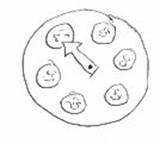 Make Prayer Spinner: Use a large paper plate. Cut out a posterboard arrow and affix it as a spinner with a brad. Now, take the litany (or have the children come up with their own prayer list) and either draw small pictures around the perimeter of the plate or use stickers – world, church, American flag, fruit, airplane or boat, prison bars, stethoscope, etc. Use it in class to pray for the various needs and take it home to use there, too.
Make Prayer Spinner: Use a large paper plate. Cut out a posterboard arrow and affix it as a spinner with a brad. Now, take the litany (or have the children come up with their own prayer list) and either draw small pictures around the perimeter of the plate or use stickers – world, church, American flag, fruit, airplane or boat, prison bars, stethoscope, etc. Use it in class to pray for the various needs and take it home to use there, too.
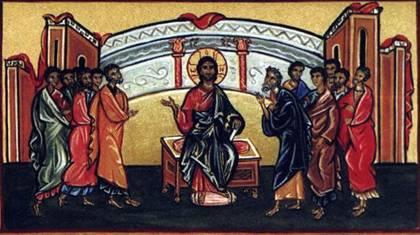
- Close with the Lord’s Prayer.
